Appendix 1: Foundation Project summaries, progress 2012 and plans for 2013
1. The TARDIS Project: Tracking ancient residues distributed in the silicate Earth
Themes 2 and 3, Earth Evolution and Earth Today, contributing to understanding Earth’s Architecture and Fluid Fluxes.
Aims: Platinum Group Minerals in chromite-rich rocks from ophiolites and komatiites can provide a faithful and robust record of the osmium-isotope composition of Earth’s convecting mantle through time; this record contains vital information on Earth’s origins and the overall evolution of its core-mantle system. In this project an international team of leading mantle researchers will use a unique combination of geochemical and isotopic techniques to decode this information and provide new insights into deep-Earth processes. Specific objectives are:
•To define the initial composition and long-term evolution of Earth’s convecting mantle, using the isotopic systematics of platinum-group minerals and sulfides from ophiolites and komatiites
•To understand the origins of ophiolitic chromitites and the processes that concentrate the platinum group elements in these and other samples of the convective mantle to help unravel Earth’s geochemical evolution
•To understand the Os-isotope heterogeneity observed in samples from the convective mantle, and how this heterogeneity may reflect major events in Earth’s evolution
•To evaluate the evidence for the preservation of large volumes of ancient continental mantle within the ocean basins
Progress during 2012
1. Significant advances in understanding Ultra-High-Pressure (UHP) systems – our deepest crust/mantle sequences:
•Zrcon data from gneisses and their enclosed peridotites in western Norway (now a classic UHP terrain) demonstrated that the gneisses were derived from the depleted mantle
ca 1700 Ma ago, and show no sign of older components in their sources; the peridotites, in contrast, proved to be Archean. This confirmed that the peridotites represent pieces of the subcontinental mantle beneath Greenland, picked up by the crustal slab when it was subducted to more than 200 km depth in the Caledonian continental collision. (Beyer et al, CCFS publication #38)
•Combined regional geology and isotopic data in the Qaidam area of North China were used to develop a model of an eclogitic “sinker” as the driving force that pulled down the continental slab, before breaking off to allow the slab to rebound to the surface. (Qiong et al. CCFS publication #136; see Research highlight)
•In 2013 this model will be extended to understand deep continental subduction at major collision zones, and to initiatie a major program of research on the UHP peridotites (“ophiolites”?) along the large suture zones across Tibet.
2. Chromitites and the genesis of ophiolites: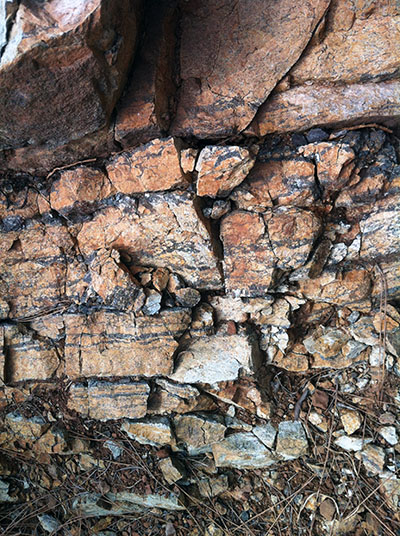
We made major breakthroughs in understanding the origins of Platinum Group Minerals (PGM) and the generation of chromitites in ophiolites.
•The demonstration of Os-isotope heterogeneity at the single-grain scale in PGM assemblages implies that chromitites form by the mixing of many individual batches of melt, derived from small isotopically distinct volumes in the convecting mantle. This discovery immediately rules out several of the previous models for chromitite generation. (CCFS publications #13, 42, 65, 71, 176, 178; see Research highlight)
•Os isotopes of PGMs also demonstrate that many ophiolites represent ancient continental lithosphere, rather than oceanic or convecting mantle. Whole-rock Os-isotope data on the Luobusa peridotites/chromitites in Tibet, which contain evidence of subduction to depths over 400 km, show that this mantle fragment is at least 3.4 Ga old. (CCFS publications #190, 239)
•A synthesis of Os-isotope data from mantle-derived xenoliths, peridotite massifs and ophiolites from central Spain demonstrated that the Mediterranean is underlain by a collection of ancient mantle fragments, with ages back into the Archean, while the surrounding areas of Europe, North Africa and the near East are underlain by SCLM that is not older than 1.8 Ga. An article (González-Jiménez et al.) will appear in Geology in 2013. (González-Jiménez et al., CCFS publication #234)
Chromite in dunite outcrop from Turkey fieldtrip.
3. Deep-crustal magmatic processes:
•Studies of ultramafic rocks exposed in Caledonian nappes in N. Norway demonstrated the existence of ultra-high-T (1600-1700 °C) dunite magmas, which caused extensive melting and assimilation of the deep-crustal rocks they intruded. This may be a relatively common phenomenon in the deep crust, and can explain many aspects of the chemistry of other ultramafic magmas such as komatiites. Dynamic modelling showed that such magmas could be derived from rapidly ascending diapirs of previously depleted/subducted mantle. (CCFS publication #237; see Research highlight)
•Detailed work on the 3.1 Ga Mpuluzi and related granites, a gigantic sill complex in Swaziland, provided new insights into the generation of the great Archean granite “blooms”. We confirmed that the entire volume of the bloom was derived from only slightly older crust (ca 3.5 Ga) and was emplaced over about 50 million years (see Research highlight). This magmatism stabilised the craton for the next billion years; modelling in 2013 will explore melting models and their effects on rheology. (Also links with part of Foundation Project 3 and the PhD project of Rosanna Murphy)
4. Mantle eclogites: our deepest cratonic samples:
•A multidimensional study showed that eclogites from kimberlite pipes record a wide range of metasomatic processes: 95% of the samples have suffered total makeovers of their major-element, trace-element and isotopic (Sr, Nd, Hf, O, C) compositions, including the deposition of diamonds. (CCFS publications #15, 41)
•Previous models for the origins of mantle eclogites, involving subduction of crustal materials, are based on faulty premises about their geochemistry, and are thus invalid. However, our studies have demonstrated that the eclogites can tell us a great deal about magmatic and fluid-related processes in the deepest parts of the cratonic mantle. (CCFS publications #15, 41; see Research highlight)
Short overviews:
•A study of the residence and mobility of gold in the mantle showed that sulfides are the main host for gold (see Research highlight)
•A study of the microstructure of mantle-derived samples has been commenced, integrating water content, composition and modelling with geophysical data to better understand lithospheric structure (see Dr Takako Satsukawa)
The projects of PhD students Qing Xiong, Ed Saunders and Nicole McGowan were an integral part of this research.
This project was closely involved in 2012 with the CCFS Technology Development projects including ion-microprobe method development (see the CMCA Report), and the refinement of Mg-isotopic analysis in the GAU at Macquarie.
Outputs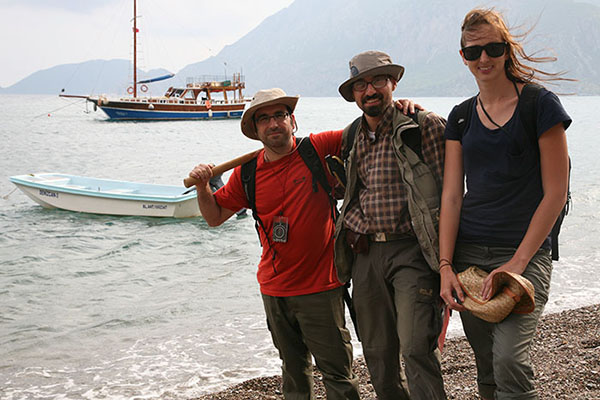
Publications:
CCFS publications (2012) #13, 15, 31, 38, 42, 65, 71, 136, 176, 178, 190, 234, 239.
See Research highlight.
Abstracts:
30 international conference presentations
José María González-Jiménez, Mehmet Akbulat (Dokuz Eylül Üniversitesi in İzmir), and Nicole McGowan, hunting down ophiolites in Turkey.
Aims and work plan for 2013
The main aims of the project remain unchanged for 2013, but we have added a focus on the UHP ”ophiolites”. We will collaborate with Professors Yang and Robinson, and Dr Shi, on further detailed studies of the field relations, mineralogy and geochemistry of the UHP peridotites in Tibet. Bill Griffin and Jin-Xiang Huang will join Rendeng Shi for field work in Tibet in May, to get a first-hand look at these significant rocks. Further field work will be done in Turkey, and more extensive collections of ophiolite material will be provided by collaborators. The work on these will follow the template developed in 2011 and 2012. The chromite database will be expanded significantly, to test the synthesis achieved in 2012; this work will be prepared for publication and presentation in international fora.
Qing Xiong will continue studies of the Tibetan ophiolites, and Nicole McGowan will continue on her project on the ophiolites of Tibet, Spain and Turkey. Jin-Xiang Huang will carry out detailed studies on a new set of Type II eclogites provided by Prof D. Mainprice (Montpellier), and will work with Nicole on the development of techniques for the analysis of Mg-Fe isotopes in mantle rocks. She also will complete the development of standards for the SIMS analysis of O isotopes in mantle-derived Cr-bearing garnets, and use this to investigate metasomatic effects in deep-seated garnet peridotites.
2a. Metal sources and transport mechanisms in the deep lithosphere
Theme 3, Earth Today, contributing to understanding Earth’s Architecture and Fluid Fluxes.
This project is designed to (1) provide new knowledge of the character and behaviour of Earth fluids, such as silicate and sulfide melts, brines, vapours, hydrocarbons, supercritical fluids, in mantle rocks at the P-T conditions of the lower lithosphere and asthenosphere and (2) unravel the complex transport and concentration mechanisms of siderophile-chalcophile elements such as Ni, Cu and PGE in the deep lithosphere.
Context and rationale:
Despite the significance attributed to mantle-derived fluids as key elements in the transport and concentration of metals within the crust, we lack a robust understanding of the processes through which the mantle evolves and interacts with fluids at sub-crustal depths, in the lithospheric mantle and asthenosphere.
The rationale of this multi-scale integrated study is to address this void in our understanding through (1) designing a set of key experiments to evaluate the chemical behaviour of fluid systems at lithospheric mantle-asthenospheric conditions, and (2) parameterising and testing these experiments through the measurement of rock samples collected from two key areas:
(a) the Ivrea-Verbano Zone in northern Italy and (b) the granulite facies terrains of South Eastern Greenland.
As well as representing direct exposure of continental lithospheric mantle rocks, these zones host unusual nickel sulfide deposits that offer rare insight into how metallogenic fluids behave at such depths. Most known world-class nickel sulfide deposits were emplaced far from their primary mantle metal sources, at the surface or in the uppermost levels of the lithosphere. The nickel sulfide systems of the Ivrea-Verbano Zone and in the granulite terrains of Eastern Greenland, however, were formed in the mid-to-lower crust and upper lithospheric mantle. Evaluation of these areas thus offers critical insight into the deeper behaviour of mantle-sourced metallogenic fluids that is not currently incorporated into deposit evolution and exploration models.
As a corollary to these two key research streams, the proposed study will also investigate the optimisation and integration of analytical techniques to constrain the behaviour of fluids and melts at relevant P-T conditions. This approach will provide improved insight into the meaning and significance of the geochemical signature of deep mineral systems, with a specific focus on the Nickel Mineral System. Consequently, the experimental results from the proposed study will generate new parameters that can be integrated in the predictive modelling of metal reservoirs, contributing to improved exploration models and opening up new exploration search space for nickel sulfide systems in the deeper portions of the lithosphere.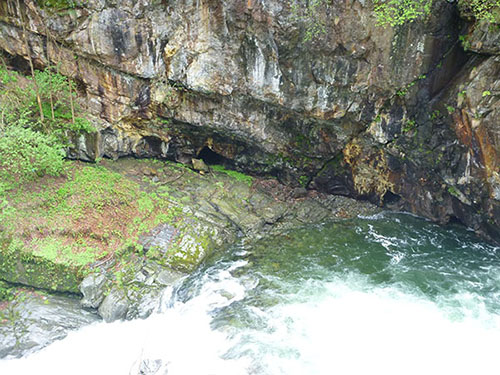
Figure 1. The impervious location of the Gula Nickel Mine, Ivrea-Verbano Zone, Italy.
Progress 2012
Study on the Ivrea-Verbano Zone:
In 2012, two field seasons have been completed in May and September-October. The first sampling trip was in collaboration with researchers from Leoben University (Austria). The second trip mapped all available outcrops and identified areas of specific interest where more detailed structural work could be completed in 2013. It is crucial to emphasise that Prof Steve Reddy from Curtin University came along to the Ivrea-Verbano Zone on the second field trip. His visit was crucial to the understanding of the structural and geodynamic setting of the area. His presence in the field is part of the ongoing collaboration between researchers involved in Foundation Projects 2a and 2b. In addition, Olivier Vanderhaege (Prof at Universite de Nancy, France), Celia Guergouz (Masters Student, Universite de Nancy, France) and Nicholas Thebaud (CET, UWA) joined us in the field. Their input was crucial to understanding the geotectonic evolution of the IVZ: further work is planned with them in 2013.
Electron microbe work on silicate and oxide phases from a wide range of locations was undertaken at Leoben. Laser ablation ICP-MS data of amphibole and phlogopite from several pipes in the Ivrea-Verbano Zone were generated in the GEMOC Geochemical Analytical Unit at Macquarie University. Preliminary data suggest that juvenile, carbonate-rich mantle water played an important role in the genesis of the pipes. It is argued that the mantle-derived metasomatic fluid not only carried metals such as nickel, iron and copper, but also increased the water activity, causing the parental rock to undergo partial melting. The melts then evolved into the volatile-rich, pipe-like intrusions that reached sulfide-saturation during their emplacement, thus forming the sulfide deposits that we see today.
Study of the Thrym Complex of Southeastern Greenland:
During 2012, fieldwork was carried out from the 26th of July to the 4th of September. During the fieldwork field relationships were documented in detail and 87 samples were collected. Of those samples the whole-rock geochemistry was determined for 66 samples. A database was constructed containing the data pertaining to the samples collected in both 2011 and 2012. Analysis of the geochemical data was carried out and a manuscript entitled “The Archaean Thrym Complex of southeastern Greenland: Sulfide mineralisation in the lower crust.” was drafted and will be submitted in early 2013.
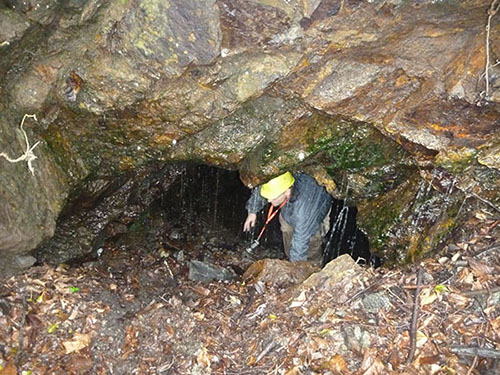
Figure 2. Marek Locmelis emerges from the wet entrance to the Valmaggia Nickel Mine, Ivrea-Verbano Zone, Italy.
Experimental study of the metal transport capacity of aqueous fluids in the mantle lithosphere:
In 2012, twelve high pressure and temperature experiments (at 0.5-3.0 GPa and 950-1100 °C) have been conducted to determine the partitioning of minor and trace elements (including chalcophile metals) between hydrous fluids, peridotite minerals and typical intraplate basanitic melts. Five experiments were also conducted under H2O-undersaturated conditions on coexisting basanite and sulfide melts. The fluid/mineral/melt partitioning data, combined with previously obtained mineral/melt partition coefficients for the same basanite, provide information on the contrasting abilities of H2O-fluids and silicate melts to transport metals and incompatible elements within the mantle lithosphere.
The successful experiments have resulted in a small but unique data set for H2O-fluids in equilibrium with mantle phases. At 950-1100 °C and 2.0 GPa the fluids contain 15-25 wt. % of dissolved solute. The solutes are enriched in SiO2 (56-66 wt. %), Al2O3, and alkalis (10.9-12.6 wt. % Na2O + K2O) but depleted in TiO2, FeO, MgO and CaO relative to the basanite. Overall the transport capacities of H2O-fluids within the upper mantle are distinctly different from those of silicate melts (Fig. 2). Alkalis, Pb and Ag are relatively enriched in the aqueous fluids, whereas most chalcophile and incompatible elements are not.
Outputs
Publications:
CCFS publication #277
Abstracts:
M. Locmelis, J. Adam, F. Zaccarini, M.L. Fiorentini, T.A. Rushmer, G. Garuti, S. Turner, P. Kollegger and E. Davies, 2012. Metal transport between the upper mantle and the lower crust. American Geophysical Union’s 45th Annual Fall Meeting, San Francisco, California, 3–7 December 2012.
M.L. Fiorentini, L. Bagas, J. Owen, B. Lally, B. M. Stensgaard, J. Kolb, N. Thebaud, 2012. A joint CET-GEUS-BMP research project: Nickel mineral systems in Archaean ultramafic rocks in South-East Greenland. Greenland Day, Perth, Western Australia, 4 December 2012.
M.L. Fiorentini, B. M. Stensgaard, J. Kolb, L. Bagas, 2012. The potential for nickel mineralisation in entire Greenland. Greenland Day, Perth, Western Australia, 4 December 2012.
Aims and work plan for 2013
Ivrea-Verbano Zone Studies:
In 2013, two more extended field seasons are planned in August and September 2013. The focus will be on the sites that were identified during the sampling campaigns in 2012. In terms of analytical work, mineral chemistry of all phases of interest will be completed. Modelling of the composition of the source region and primary melts that evolved to form nickel-sulfide mineralisation will be undertaken. More importantly, the study will integrate the data from the natural samples collected in the Ivrea-Verbano Zone with a series of hydrous high-pressure and high-temperature experiments to investigate the capacity of near-solidus melts and fluids to transport metals at lithospheric mantle-asthenospheric conditions.
Study of the Thrym Complex of Southeastern Greenland: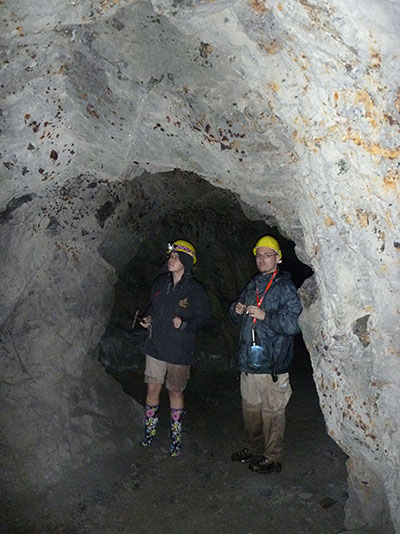
In 2013, selected samples of the felsic orthogneisses will be used for geochronological U/Pb zircon analysis in the SHRIMP. Representative samples of the ultramafic rocks will be characterised in petrography and detailed mineral chemistry in preparation for detailed metamorphic studies to be carried out in collaboration with Alfons Berger at University of Bern, Switzerland. A manuscript for the geochronology of the felsic orthogneisses and the stratigraphy of the Sehesteds Fjord section will be prepared. Stable isotope studies will be carried out on selected samples, both O and H for amphiboles and multiple sulfur isotopes.
Experimental study of the metal transport capacity of aqueous fluids in the mantle lithosphere:
The experiments experienced an unexpectedly high failure rate, partially due to equipment failure but also to the unfamiliar nature of some of the materials and experimental designs employed. However the lessons from the unsuccessful experiments in 2012 have helped in the design of future experiments and equipment acquisitions which should avoid these problems. A particular feature of the experimental approach adopted is that it avoids the use of fluid traps (including carbon spheres and fluid inclusions in solid minerals), such as are commonly employed in similar experiments. This allows the experimental run products to be unambiguously identified and analysed.
In 2012, particular difficulties were experienced with experiments on sulfide-enriched compositions (owing to the tendency of sulfur to attack the capsule materials). In 2013, this problem will be overcome by the use of gold capsules. The use of gold capsules will also allow the fluid-saturated experiments to be extended to include sulfide- and halide-enriched compositions. The effects of variations in ƒO2 will also be examined.
Figure 3. Ellen Davies and Marek Locmelis in the Valmaggia Nickel Mine, Ivrea-Verbano Zone, Italy.
2b. Dynamics of Earth’s mantle: assessing the relatives roles of deformation and magmatism
Theme 3, Earth Evolution, contributing to understanding Earth’s Architecture.
Understanding the evolution of continental and oceanic mantle in extensional environments is key to understanding plate tectonics. How and why divergence initiates in extensional zones, and how continental rifts evolve to oceanic accretion centres are poorly constrained processes, but fundamental to our understanding of the processes structuring the lithosphere. This project explores the upper mantle in rifting and ocean-continent transition environments. We will study several localities, such as the East-African Rift (Marsabit, Kenya) and Platta massif (Alps) to find how the deformation has been initiated, localised and evolved in such geological settings, and what are the structural and geochemical relationships with fluids. We will characterise the microstructures and the deformation mechanisms recorded by mantle minerals, such as olivine and pyroxenes, with EBSD technique. We will determine the evolution of the deformation related to the extensional settings.
Progress during 2012
The study of the East-African Rift (Marsabit, Kenya) mantle xenoliths is now finalised with the submission of a paper to Tectonophysics. The microstructural study of high-strain mantle peridotite xenoliths from the East African rift in Kenya (Marsabit volcanic field) has been conducted to investigate lithospheric mantle deformation related to continental extension. The xenoliths are spinel peridotite xenoliths displaying a range of textures from porphyroclastic to ultramylonitic. Bulk rock fabric analysis of almost all samples indicates a dominant (001)[100] (E-type) slip system, with only one porphyroclastic sample showing the more classical (010)[100] (A-type) fabric. A weak E-type fabric is also present within the fine-grained matrix of the mylonitic and ultramylonitic peridotites. Weakening is probably the effect of dynamic recrystallisation, diffusion creep and grain boundary slip. Detailed inspection of the microtexture of individual olivine grains within the xenoliths indicates the operation of multiple slip systems A-, E-, to C-type even in a single sample. The individual olivine grains show that with increasing strain the dominant slip direction changes from [100] to [001].
This study confirms the activity of the E-type slip system in a rifting environment and provides the first evidence of [001] slip in such environments. The variability of the slip systems shows the heterogeneity of the deformation mechanisms, and probable heterogeneity of strain partitioning in the Marsabit mantle. The presence of highly deformed peridotite testifies to zones of intense deformation and strain localisation in the shallow lithospheric mantle, most likely associated with the decrease of pressure and temperature. In the Marsabit peridotite, the decompression and cooling from high-pressure/high-temperature to lower-pressure and temperature could be the major factor influencing the localisation of deformation and the change in the dominant slip direction in olivine. Our new results highlight that mantle recording exhumation in rift margin is deformed under an E-type regime and becomes more C-type when deformation is localised. The activation of these two slip systems in peridotite might be an indicator of the early stages of deformation in extensional rift margin setting.
A fieldwork season was done in late-June/early-July by Mary-Alix Kaczmarek and Steve Reddy in the Eastern Alps, Switzerland (Fig.1). The Platta and Totalp massifs have been visited because they represent a type example of a zone of exhumed continental mantle, and they offer a complete sequence of an ocean-continent transition (more details in Research highlight).
Fieldwork in the upper mantle reveals a heterogeneous distribution of deformation within the peridotite sequence.
The peridotite is more deformed in the upper part of the mantle sequence, and contains metre to centimetre high-temperature shear zones. The sampling done across the mantle sequence will permit a detailed study of the peridotite texture relative to its position in the sequence. A series of thin sections have been received in late 2012 and will be the base for 2013 work.
Outputs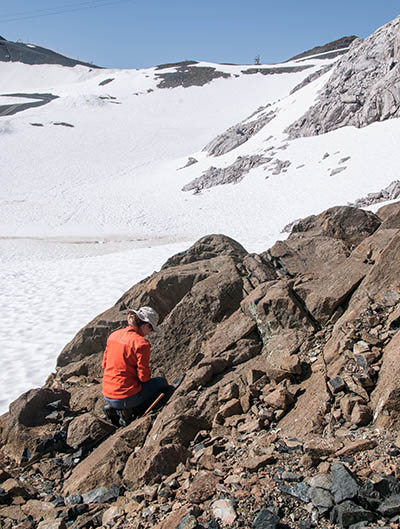
Publication:
Kaczmarek, M.-A. and Reddy, S. Mantle deformation during rifting: Constraints from quantitative microstructural analysis of olivine from the East African Rift (Marsabit – Kenya). Tectonophysics. (Submitted)
Abstracts:
M.-A. Kaczmarek The understanding of mantle shearing with EBSD. ACMM 22 /APMC 10 / ICONN 2012, Perth, 5-9 February.
M.-A Kaczmarek., and S. Reddy Mantle deformation during rifting in East Africa (Marsabit - Kenya). IGC, Brisbane, 5-10 August.
Aims and work plan for 2013
In 2013, laboratory work on previously (2012) collected material in the Alps will be implemented. The first step is to undertake a detailed petrographical study of the samples to characterise the microstructures and parageneses in relation to their position in the mantle sequence. Then, selected samples will be mapped using EBSD (Electron Backscatter Diffraction) to characterise the preferred crystallographic orientation of minerals (CPO). The CPO will give an indication of the mechanisms that were activated during the exhumation of the mantle, to better understand the processes leading to localisation of deformation in ocean-continent transitions. In parallel, the chemical composition of the minerals measured using electron and ion microprobes will determine the chemical variability within the mantle sequence to study the percolation of fluid/melt during exhumation, and the relationship between chemistry, fluids and deformation.
The chemical composition of the minerals will be used to estimate temperatures, and to constrain the conditions that activate deformation mechanisms.
Figure 1. Mary-Alix Kaczmarek making structural measurements in the field.
3. Generating and stabiliSing the earliest continental lithosphere - Large granite blooms 
Theme 2, Earth Evolution, contributing to understanding Earth’s Architecture and Fluid Fluxes.
The project aims to understand the genesis of the earliest continental lithosphere, including the processes of fluid/melt extraction that stabilise, and thus preserve, Archean cratonic lithosphere. This will involve isotopic studies of zircons from ancient terrains and deep-crustal xenoliths worldwide, to further constrain the nature of the oldest preserved crust, and a continued search for the oldest mantle samples beneath cratonic areas. Targeted studies involving (1) a regional characterisation of the 3.1 Ga Mpuluzi batholith (Swaziland/RSA) and (2) a similar characterisation of the end-Archean granites of the North China Craton, will provide a basis for static and dynamic modelling of the rheology of the crust before, during and after melt extraction.
This project has close linkages with the research of Future Fellow Dr Elena Belousova. This will involve regional surveys (TerraneChron® approach) of zircons (U-Pb, Hf isotopes, O isotopes) from old continental areas, in an attempt to pick up the signatures of the oldest crust. The project also will study zircons from deep-crustal and mantle xenoliths in basaltic and kimberlitic rocks, to look deeper into the lithosphere. This work will be integrated with Os-isotope analysis of sulfides in the mantle xenoliths (see TARDIS-E project) to define the origins of the subcontinental lithospheric mantle beneath the old areas where ancient crust is identified, and constrain the role of the SCLM in stabilising ancient crust.
Two targeted areas will be investigated to look at some of the processes of crustal stabilisation. The Barberton Greenstone Belt and Ancient Gneiss Complex in Swaziland and adjacent RSA represent some of best-preserved and most-studied Early- to Mid-Archean (3.6 to 3.2 Ga) crustal remnants. There are several models for their formation, ranging from oceanic to continental settings; all may need revision in light of Sm-Nd data and unpublished zircon-Hf data (A. Kroener, pers. comm.) that indicate the participation of older crust (model ages ≥3.8 Ga). However, it is clear that the tectonic and magmatic processes that produced the greenstones, associated TTG magmatism, sedimentation and (locally high-grade) metamorphism ended abruptly at ca 3.1 Ga, with the emplacement of regionally extensive granitic magmas (Mpuluzi granodiorite, Nelspruit potassic granite, Boesmanskop syenite, Salisbury Kop granodiorite). These form thick sheets extending over at least 10,000 km2. This intrusive episode marks the final cratonisation of the crust in this area; little happened thereafter until ca 2.5 Ga. The sheer volume of these magmas raises several fundamental questions relevant to the generation and stabilisation of ancient crust in general.
(1) What sort of materials were melted to produce the magmas?
(2) Where did the heat come from?
(3) What controlled the formation of regionally extensive sheets, rather than deep-rooted batholiths?
(4) How many different pulses of magma were involved, and over what time span?
Collaborators include Professor Alfred Kroener (Mainz and Beijing), a world-recognised expert on Precambrian geology and, in particular, that of southern Africa. This incorporates the PhD project of Ms Rosanna Murphy, who began in 2011 with Professor Alfred Kroener as an external supervisor.
The second area to be investigated will be the southern part of the North China Craton, where a similar “granite bloom” at the end of the Archean appears to have been the defining event that stabilised the crust, although studies of deep-crustal xenoliths have already shown that felsic-intermediate crust was already in place by 3.4 Ga.
Progress during 2012
Dr Belousova started her Future Fellowship project in 2012 and has already produced results contributing to our knowledge of the structure of the Archean crust in the Volgo-Uralia region of the of the East European Craton. She has also begun work on samples from unique drill-core material (depths over 10,000 km) of both Archean and Paleoproterozoic rocks from Volga-Uralia and Baltic Shield (Kola super-deep drillhole).
PhD student Yuya Gao (cotutelle with CAS, Beijing, a CCFS Partner) began a thesis analysing Li isotopes in A-type granites, following from the success of Dr Xian-Hua Li in establishing
this technique during 2011. These granites are typically the
latest components in “granite blooms” and this work will be directly relevant, as an analogue, to the aims of the project.
A paper dealing with the zircon systematics of the samples was submitted for publication in 2012.
PhD student Rosanna Murphy presented her preliminary work at an international conference in Johannesburg in January 2012; this was followed by a field trip that allowed her to carry out further sampling, and to link up with a French group who have overlapping interests in the area. The samples she returned have been processed, including whole-rock isotopic studies on selected samples. The zircons have been analysed for U-Pb ages, Hf-isotope composition, and trace elements; a selection has also been analysed for O isotopes at CMCA. The results support the work on the earlier sample sets; they have confirmed the narrow spread of intrusion ages around 3.1 Ga, and a scattering of older inherited zircons, stretching back to 3.5-3.6 Ga. This is consistent with the Hf isotopes, which give model ages in the same range. There is, thus far, little evidence of a Hadean crust in the area.
See Research highlight.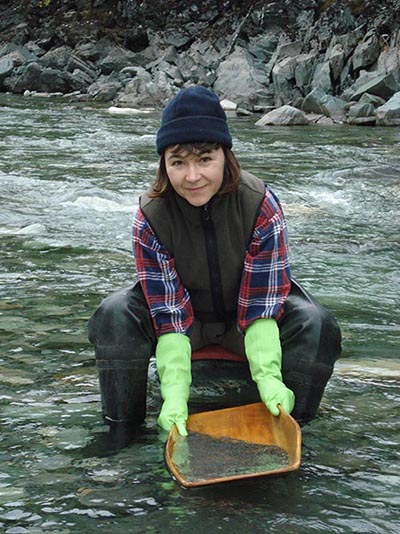
Visiting PhD student Qian Liu (from China University of Geosciences, Wuhan) employed zircon geochemistry and geochronology from Mesozoic granites representing two timeslices in southeastern China, to demonstrate the power of zircon geochemistry as a remote sensor for paleogeodynamics (see Research highlight)
Dr Elena Belousova sampling the rivers and streams of Yakutia.
A synthesis of lithosphere evolution incorporating zircon geochemistry and geochronology from this project was presented as an invited lecture “The world turns over” at the 34th IGC and has been submitted for publication
Outputs
Publications:
CCFS publications #12, 97
Aims and work plan for 2013
The aims of the project will remain unchanged. Dr Belousova and Ms Gao will continue their analytical work in 2013.
Dr Belousova will carry out more analytical work on samples collected from Russia and Spain.
Analytical work for the African Craton part will be finalised, and a paper prepared on the geochemical outcomes; these data will provide the constraints for a program of thermal/compositional/dynamic modelling (with Dr Craig O’Neill) to explore the processes that produced these huge volumes of magma in such a short time. One possibility to be tested is the in-situ heat generated by a K-U-Th-rich deep crust blanketed by a refractory upper crust; another is a deep-seated source such as a mantle overturn.
4. Two-phase flow within Earth’s mantle: modelling, imaging and application to flat subduction settings
Theme 3, Earth Today, contributing to understanding Earth’s Architecture and Fluid Fluxes.
The overarching goal of this project is the development and application of an in-house state-of-the-art computational tools to simulate and image complex geochemical-geodynamic processes involving two-phase reactive flow in multi-component deformable media. These tools, in combination with advanced seismic imaging techniques, will be applied to the problem of fluid transport from shallow-dipping to flat subduction settings, in both the western USA and South China in the past.
Progress during 2012
People:
A full-time technical staff member was employed in early 2012 (Farshad Salajegheh) to assist with development and application of the numerical tools.
The postdoctoral position was advertised, and candidates shortlisted. A formal offer was finally made to Siqi Zhang, who will be arriving on the 20th of February 2013 to begin work on the project.
Dr Zheng visited Yingjie Yang for about one month late in 2012 to work on seismic imaging of upper mantle structure. He has mastered the tomographic method applied for upper mantle imaging during the last trip.
We have also had 4 PhD students begin in 2012, working on issues related to the project:
Chris Grose: The nature and thermo-chemical evolution of the oceanic lithosphere
Beñat Oliveira Bravo: Two-phase multi-component reactive transport in the Earth’s lithosphere and mantle
Chengxin Jiang: Imaging the crustal structure of Northern Tibet and surrounding regions by Ambient Noise Tomography
Shahid Ramzan: The strength of oceanic plate-bounding faults.
Outputs
Publications:
Early work utilising the multicomponent mantle flow framework available in CitcomS have been submitted, e.g:
O’Neill, C. Debaille, V., Griffin, WL., (submitted, AJS), Deep Earth Recycling in the Hadean and constraints on surface tectonics.
Also work on the utilisation of Underworld for subduction modelling and melting calculations was submitted:
O’Neill, C., Lenardic, A., Coltice, N., Moresi, L. (submitted), Divergent tectonic evolution of Venus and Earth from 40Ar constraints, in: Comparative Climatology of Terrestrial Planets, Arizona Press Space Science Series.
Development of the tomographic imaging was published in: CCFS publications #35, 217
Work on the probabilistic inversion for lithosphere/mantle structure is appearing in: #217, 218
Conference Presentations:
Some selected presentations of special relevance to the project’s science themes:
Applications of long period surface wave dispersion measurements from ambient noise in regional surface wave tomography, Y. Yang and C. Jiang, S53C-2516 American Geophysical Union’s 45th Annual Fall Meeting, San Francisco, California, 3-7 December.
Grose, C.J. and Afonso, J.C. (2012), Petrology of oceanic lithosphere from thermodynamic models: implications for geophysical observations and geodynamics. AGU Fall meeting, San Francisco, T43F-2755.
Afonso, J.C., J. Fullea, Y. Yang, N. Rawlinson, A.G. Jones, J.A.D. Connolly (2012), Towards multi-observable thermochemical tomography of the lithosphere and sublithospheric upper mantle. AGU Fall meeting, San Francisco, V51D-03.
O’Neill, C., Afonso, J.C., The role of serpentinisation in fault stress and long-term deformation in the Java-Sumatra subduction system, Specialist Group in Tectonics and Structural Geology (SGTST/GSA) Bi-annual Conference, Waratah Bay, 29 January -
3 February 2012.
O’Neill, C., Deep Earth recycling in the Hadean (Invited Keynote talk), 34th IGC, Brisbane, August 2012.
O’Neill, C., Plate tectonics: A phase a planet goes through?
34th IGC, Brisbane, August 2012.
Debaille, V., O’Neill, C., Brandon, AD., Haenecour, P., Yin, Q.-Z., Mattielli, N., Treiman, AH., How to preserve a chemically heterogeneous martian mantle? A plate tectonics point of view. MetSoc 2012, Cairns, August 2012.
Leverage:
A NecTar (nectar.org.au) grant was successful which leverages off the Underworld development component portion of this project (project funded through Monash – Macquarie subcontracting off this arrangement - $364K NecTar funding, $372 co-investment, including in-kind contribution. Net cash flow to Macquarie of $60K per year for the duration of the project).
A description of the project follows:
Geology from Geodynamics — a geophysics workflow for Underworld
This new research tool is designed specifically for use by Australian geologists and geophysicists. It will enable the geology, geophysics and geodynamics research community to link into industry-standard 3D modelling to access geophysical data for improved accuracy when using 3D modelling technology. This new tool will help link workflows from both commercial and research-developed geophysics modelling software.
Aims and workplan for 2013
The aims in 2013 are to begin development on the implementation of mantle rheology formulations and MCMP flow in Aspect, a new, cutting edge FEM formulation for simulating mantle flow, based on the deal.II FEM library. The code is a collaborative effort, partly orchestrated by the CiG consortium. Siqi Zhang is familiar with the architecture of the software and will be heavily involved in bringing it up to usability for CCFS problems.
Application work will continue on CitcomS and Underworld (the latter supported by NecTar funding), and additional papers on upcoming results will be submitted this year.
Afonso and Oliveira will work on novel multi-scale algorithms for two-phase multi-component reactive flow in the Earth’s mantle.
Seismology will continue its existing research collaboration stream with Wuhan, factoring in a long visit for Zhang and some of his group in 2013. With the development of the imaging and maturation of the modelling components, we will also draw in Li’s (Curtin) expertise in the local area geodynamics of South China in developing an integrative approach to exploring the problem.
5. early evolution of the Earth system and the first life from multiple sulfur isotopes

Theme 1, Early Earth, contributing to understanding Earth’s Fluid Fluxes.
Aims:
1. To define the nature of the first life in the early Archean and links between the early evolution of life and the rise of atmospheric oxygen in the Neoarchean.
2. To understand the evolution of the Earth’s oceanic and atmospheric composition during the Archean and Paleoproterozoic.
3. To evaluate the links between the evolution of the sulfur cycle and the formation of important Archean submarine ore deposits.
Context and rationale:
Mass-independent fractionation (MIF) of multiple sulfur isotopes (∂ 34S, Δ33S and Δ36S) in rocks older than 2.45 Ga provides the best evidence for changes in early Earth’s atmosphere and ocean due to the evolution of the sulfur cycle. Recent work indicates that variations in the MIF record have important implications for understanding changing environmental conditions in the evolving Archean Earth system. Prior to 3.1 Ga the record is characterised by significant MIF, with reduced variation between 3.1 and 2.8 Ga and increased variation from 2.75 to 2.5 Ga, followed by reduction as the Great Oxidation Event occurred between 2.45 and 2.32 Ga. We have the capability to analyse samples that may resolve how these changes were linked to tectonic events (e.g. a fluctuating sulfur cycle linked to increased subaerial volcanic gas as continents grew) and the evolution of life. Multiple sulfur isotopes are important to investigation of biological processes on the early Earth. They provide the potential to elucidate the types of life present in Earth’s earliest sedimentary environments, and to trace the transfer of sulfur in fluids and gases from the interior of the Earth, via the atmosphere and hydrosphere into the biosphere.
Although compilations of sulfur isotope data from Archean sedimentary rocks indicate the sulfur content of oceans was very low, Archean greenstone successions contain some of the world’s largest submarine metal sulfide deposits, and these commonly have non-zero ∂ 33S values. A better understanding of the role of different sulfur sources in Archean mineral systems will provide important insights into the evolution of the early sulfur cycle and keys for exploration. Also analysis of multiple sulfur isotopes in sulfide inclusions in mantle derived diamonds and eclogites from kimberlites has the potential to tell us how Archean sulfur was recycled to depth in the crust and mantle and sulfide inclusions in Hadean zircons and meteorites have potential for understanding very early Earth fluids.
One problem that has held back research in the biological field is the spatial resolution at which multiple sulfur isotopes can be analysed. Bulk analyses can lead to artificial homegenisation of sulfur isotope signals in a sample, and a lack of understanding of processes on the micron scale, where microbial mediation may be observed. For example, recent Nano SIMS sulfur isotope studies have revealed large variations in ∂ 34S in both modern and ancient microenvironments. These small-scale heterogeneities in sulfur isotope composition cannot be detected by bulk techniques, and emphasise the growing need to study sulfur isotopes on a spatial scale relevant to microbial processes. Hence, as an extension to studying multiple sulfur isotopes in Archean sediments and mineral deposits we will also investigate the biogeochemistry of sulfur using samples from key times in Earth history (e.g. early Archean to investigate Earth’s earliest life; late Archean to investigate the interplay between sulfur metabolisms and the rise of atmospheric oxygen), and will incorporate new technology available at the CMCA. An increased understanding of the biological S-cycle is not only important for studies of life in the Archean, but also for elucidating the composition of the early atmosphere, the mechanisms for cycling of these elements between the lithosphere, biosphere and atmosphere, and the cycling of other elements essential for life.
Methods/methodologies:
The major aims of the project require analysis of multiple sulfur isotopes from relevant samples, some that we already have and others to be collected soon.
The most appropriate method for bulk multiple sulfur isotope analyses is use of the EA-CF-IRMS at the University of Queensland (key analyses in the 2009 DP) this will be used to see which sedimentary and mineral deposit samples require more detailed spatial analyses. The CAMECA IMS 1280 ion microprobe is capable of measuring ∂ 34S and Δ33S with precisions of better than 0.2‰ and from samples as small as ca 15 mm. For Δ36S it can achieve precisions of better than 0.3‰ from samples as small as ca 40 mm. The CAMECA Nano SIMS 50 extends this capability to samples as small as 2-3 microns for ∂ 34S. This will allow us for the first time to analyse ∂ 34S, Δ33S and Δ36S from individual sulfides and sulfates at the correct scale to identify individual microbial processes.
Innovation:
This is the first time all three analytical methodologies for multiple sulfur isotopes have been available in Australia and will provide the chance of very important high-impact results and one of the best global databases.
Progress during 2012
The research plans for this project are to obtain appropriate samples and undertake the necessary analyses; we will target key areas and important mineral deposits in the Murchison and West Pilbara. We have been able to get appropriate sample sets from Mesoarchean (3.3 to 2.8 Ga) greenstone belts and volcanic hydrothermal massive-sulfide deposits and komatiite-hosted Ni-sulfide deposits. Australia is the only place with a wide variety of samples of this key age, which has been a gap in the existing global database. We have gotten excellent first results from the 2.9 Ga Lake Johnston Belt and the Murchison area, showing key evidence for variations in the sulfur cycle through this period of time. This contrasts with previous data, which have suggested rather minor oxygen-fugacity variations before the great oxidation event. These data show that the strongest variations in the Mesoarchean S-MIF record are linked to the only preserved evidence for major volcanic events, suggesting that subaerial volcanism produced the key volcanic gases. The largest 2.95 Ga Mesoarchean deep-submarine volcanic massive-sulfide deposit, Golden Grove, is evidence for major sulfur recycling after plate tectonics started. These are important results and we will submit them to key journals in the next few months. The CIs have given talks at conferences and PhD students have had talks and posters. PhD student Carissa Isaac (started 2010) whose initial analytical work was partly supported by the Discovery Grant (VMS and sedimentary S isotopes in the North Eastern Yilgarn), has gotten a larger and more appropriate batch of samples for ongoing research in this project; she gave presentations and posters at conferences in 2012, and will publish papers and complete her thesis in 2013.
There are three PhD students working on this project, giving us the potential for some important milestones in the hope of providing a better understanding of the variations of the sulfur cycle and its links to tectonics, life and mineral deposits in the early Earth between 3.5 and 2.4 Ga.
Using the different methods described above has given us the first clear data on how the methods fit together for this important work. We have been collaborating with international leaders in multiple sulfur isotope geochemistry (James Farquhar, Boz Wing, Shuhei Ono, Doug Rumble, Sue Golding, Jay Kaufman etc.) in 2011, 2012 and 2013.
David Wacey’s CCFS Research Fellowship commenced in 2012. As part of CMCA, his expertise lies in early life and related biogeochemistry and astrobiology (illustrated by his publications and conference presentations), he has collected a quality set of samples and has a high level of experience using Nano SIMS and IMS 1280. David has a paper in review and one more to be submitted soon and is expecting his key international collaborations to continue in 2013.
Outputs
Publications:
CCFS publications# 182, 183
Conference Presentations 2012:
M.E. Barley, Links between tectonics and life, 4.0 to 2.3 Ga and the rise of oxygen. Abstract, Goldschmidt Conference 2012.
M.E.Barley, S.D. Golding, M.L. Fiorentini, The first multiple sulfur isotope evidence for a 2.9 Ga Mesoarchean sulfate reservoir linked to a major volcanic event. Abstract, 34th IGC 2012.
C. Issac, M. Fiorentini, B. Wing, S. Golding and M.Barley, Distribution of sulfur reservoirs through the Archean in the North Eastern Goldfields, Yilgarn Craton, Western Australia and their significance for nickel sulfide formation in komatiites. Abstract, 34th IGC 2012.
N. McLoughlin, E.G Grosch, M.R. Kilburn and Wacey, D. 2012. Evaluating the earliest traces of Archean sub-seafloor life by NanoSIMS. Abstract, AGU Fall Meeting, San Francisco, USA.
N.N. Noffke, D. Christian, D. Wacey and R. Hazen 2012. A microbial ecosystem in an ancient sabkha of the 3.49 Ga Pilbara, Western Australia, and comparison with Mesoarchean, Neoproterozoic and Phanerozoic examples. Abstract, GSA Annual Meeting, Charlotte, USA, 4-7th November.
D. Wacey, N. McLoughlin, M. Saunders and M. Brasier, Electron Microscopy of Early Cellular Life. Abstract, Scandem 2012 Annual Meeting of the Nordic Microscopy Society, 12-15 June 2012.
Aims and work plan for 2013
With David Wacey’s increasing involvement in this project in 2013, we are planning to link the variation of SMIF in different-sized sulfide minerals in areas where there has been controversy over when the first evidence for early microbes appears.
1.Obtaining bulk values of Δ36 and Δ33 on the Dresser sulfides to back up the SIMS work from last year (James Farquhar). We will use another session on the 1280 to see if the values we got last year are repeatable. Because some data suggest there was evidence for early life, we hope to provide the first unambiguous S-isotope evidence.
2.Analysing the products of lab experiments where sulfate-reducing bacteria have been used to precipitate sulfides, to see if a biological signal can be seen in Δ36S and/or Δ33S on the micro-scale. Micro-scale analyses will be done on the SIMS at UWA; bulk analyses will probably be done with James Farquhar in Maryland.
3.A different Gunflint data set, looking at possible hydrothermal pyritisation of microfossils - compare and contrast these data with those from biological pyritisation that we obtained last year.
4.Analysis of pyrite from Ediacara sediments containing macrofossils from Newfoundland to test our hypothesis that the Ediacara biota may have been thiotrophic. We are planning to get more sulfur data in 2013 - these are 1200 Ma pyrite microfossils from the Stoer Group in NW Scotland. The aim is to investigate the sulfur cycle in Proterozoic lakes. These are all focused on the Precambrian sulfur cycle and its links to early life and are relevant to the CCFS objectives and the major aims of this project.
We are continuing our collaborations with international leaders in multiple sulfur isotope geochemistry (James Farquhar, Boz Wing, Shuhei Ono, Doug Rumble, Sue Golding, Jay Kaufman) from 2011 and 2012. We plan to convene a 2 - 3 day MIF Work Shop in Australia (Sydney) in 2013 with these collaborators.
Prof James Farquhar, a pioneer of MIF, had a Sabbatical at UWA to see how his bulk analyses compared to the CAMECA NanoSIMS analyses. We hope that with his help, new bulk analyses will be completed.

Technique development for Sulfur Isotopes: Validating NanoSIMS δ34S analysis. This is a sample from the Ediacara of Newfoundland showing that NanoSIMS can be used to measure δ34S of biological pyrites. NanoSIMS data is tested against 1280 data from nearby (or sometimes the same grains). Results are nearly identical. Black = Cameca IMS 1280 data, Red = NanoSIMS data.
6. Detecting Earth’s rhythms: Australia’s Proterozoic record in a global context

Theme 2, Earth Evolution, contributing to understanding Earth’s Architecture and Fluid Fluxes.
The main goals of this project are (1) to test a groundbreaking hypothesis that the birth and death of a supercontinent on Earth’s surface is intimately linked to the spatial and temporal location of superplumes, and that cyclic supercontinent-superplume events and associated fluid events dominate Earth’s evolution; (2) pushing our knowledge of the Earth’s palaeogeographic and geodynamic history back to the Archaean.
Context and rationale:
How plate tectonics on the Earth’s outer shell interacts with its mantle, and what drives plate tectonics, remain a challenge to the 21st century geoscience community.
Does plate tectonics drive mantle convection, or vice versa? What determines the formation, positions and lifespan of hot mantle plumes and superplumes deep in the mantle, and how do plumes/superplumes interact with plate dynamics? Are mantle plumes and superplumes fixed relative to the Earth’s rotation axis? Are the formation and breakup of supercontinents in Earth’s history accidental events, or more regular events determined by some internal mechanisms?
Figure 1. Narimbunna sills in the Peedawarra area.
While working on the evolution of Rodinia, Z.-X. Li and co-workers noticed that the assembly of Rodinia was followed by a >100 million years (Ma) of worldwide plume activity that is at least temporally linked to the breakup of the supercontinent. The sequence of events resembles that during Pangaean time both in its lateral extent and its duration, including a time lag of tens of millions of years between the final assembly of the supercontinent and the onset of plume breakout. More intriguingly, Neoproterozoic palaeomagnetic data suggest that Rodinia and the mantle plumes beneath it may have rotated rapidly between ca 0.81 and 0.75 Ga, confirming that mantle plumes and supercontinents are probably coupled. Did such coupling occur during Earth’s earlier history?
In this project we will further test this hypothesis by analysing global palaeogeography back to the Neoarchaean era. Primary data gathering in the first three years will focus on numerous Paleo- to Mesoproterozoic Australian igneous complexes with studies of palaeomagnetism and geochemistry. We will compare the Australian records with those of the entire world through international collaborations.
Progress during 2012
The project made significant progress in both primary data gathering and scientific interpretation and synthesis. The combined palaeomagnetic, geochronological and geochemical analyses of mafic dykes in the Ravensthorpe region of the southeastern Yilgarn craton are nearly completed. Radiometric dating of one of the dykes confirmed the dominant presence of the ca 1.2 Ga Gnowangerup–Fraser mafic dyke swarm in the region. However, palaeomagnetic analyses also revealed the likely existence of ca 755 Ma mafic dykes, probably a southern extension of the Mundine Well dyke swarm in the northwestern Yilgarn craton. Both generations of dykes represent typical anhydrous and tholeiitic intraplate magmas with the possible involvement of recycled components in their source region. This finding is consistent with a mantle plume-origin for both events.
Figure 2. Contact between mafic dyke (left-hand side of the photo) and sediments of the late Paleoproterozoic - Mesoproterozoic Edmund Group (right-hand side of the photo). Photograph by Sergei Pisarevsky.
The palaeomagnetic results from the 1.2 Ga dykes, combined with previously reported preliminary results from the interior of the Yilgarn Craton, now make the Fraser dyke pole a rare key Precambrian pole. A revised apparent polar wonder path, when compared with that of Laurentia, suggests that (1) the late-Paleoproterozoic to Mesoproterozoic supercontinent Nuna/Columbia probably broke up before 1.2 Ga, and (2) Rodinia was not formed until after 1050 Ma. The geochemical, palaeomagnetic and geochronological data are all being written up for publication, and a more detailed presentation of the scientific findings can be found under Research highlights in the 2012 CCFS Annual Report.
We carried out a pilot sampling trip to the Bangemall Basin in Western Australia. Our main targets are the 1500-1450 Ma Narimbunna mafic sills and probably some ca 1070 Ma dykes in the Peedawarra, Tangadee and Capricorn areas (Fig.1). We collected oriented block samples for the palaeomagnetic analyses and potential geochemical and petrological analyses.
As an extension of this project, we are conducting a number of international collaborative research projects on rocks outside of Australia. One is on ca 1250 Ma mafic dyke samples from the Vestfold Hills, East Antarctica though collaboration with Russia’s Antarctic research team (samples currently being prepared). Together with colleagues from the Indian Institute of Technology Bombay, we completed a combined palaeomagnetic, geochronological and geochemical study of ca 1460 Ma Lakhna Dykes in the Bastar Craton of India. The new palaeopole helps to constrain India’s position in Nuna (Pisarevsky et al., Lithos, in press; CCFS contribution #195). We have also collaborated with Russian colleagues from the Institute of Earth’s Crust in Irkutsk on Siberian rocks. New palaeopole and geochemical characteristics of 760 Ma mafic dykes led to a new model of Siberia in Rodinia (Pisarevsky et al., submitted to Precambrian Res.). Palaeomagnetic analyses of two other collections of Meso- to Neoproterozoic mafic dykes from Siberia have been completed, and relevant manuscripts are currently being prepared. Palaeomagnetic and geochronological study of previously undated St Simeon dykes in Quebec of northern Laurentia will be presented in the EGU 2013 General Assembly and published soon after with Canadian colleagues. Palaeomagnetic and geochronological study of 2.4 Ga dykes east of Kalgoorlie, WA revealed a new palaeopole which is similar, but not identical to the pole from the 10 Ma older Widgiemooltha dykes, providing new insights into Paleoproterozoic palaeogeography and magmatism in Western Australia. The two latter studies were done in collaboration with the international LIPs project team (www.supercontinent.org). Another collaborative publication with that team on the Mesoproterozoic mafic magmatism in Angola has been recently accepted for Precambrian Research (CCFS publication #221).
A major scientific breakthrough of this project during the year is the publication of the first palaeomagnetically constrained reconstruction of the Nuna supercontinent through an ongoing international collaboration with researchers from China University of Geosciences and Yale University (see report under Research highlight).
Outputs
Publications:
CCFS publications directed linked to the project: #39, 179, 186, 195, 197, 221, 224, 250, 269, 270
CCFS Publications contributing to general CCFS goals: #16, 23, 24, 31, 34, 115, 143, 148, 156, 159, 166, 173, 193, 208, 212, 219, 223, 281, 303
2012 Conference presentations:
10 directly linked to this project, plus 10 related presentations.
Li, Z.X., Coupled supercontinent-superplume cycles and the geodynamic driving force: an overview. The 34th International Geological Congress, 5-10 August 2012, Brisbane, Australia.
Li, Z.X., Evans, D.A.D., Halverson, G.P.: Global Cryogenian and Ediacaran paleogeography: A new kinematic and lithostratigraphic model. Suprcontinent Symposium 2012, 25-28 September 2012, Helsinki, Finland.
Li, Z.X., The opening of the South China Sea: Driven by Pacific subduction, or by India-Eurasia collision? American Geophysical Union’s 45th Annual Fall Meeting, San Francisco, California, 3–7 December 2012. Keynote
Li, Z.X., Pang. C., Batt, G., Li, W.X., Xu, Y.: Large-scale and rapid vertical continental movements due to the eclogisation of a flat-subducted oceanic plateau in Mesozoic south China. The 34th International Geological Congress, 5-10 August 2012, Brisbane, Australia.
Pisarevsky S.A., 2012. Mesoproterozoic supercontinent - paleomagnetic synthesis and geological constraints. In: Mertanen, S., Pesonen, L. J. and Sangchan, P. (eds.), 2012. Supercontinent Symposium 2012 – Programme and Abstracts. Geological Survey of Finland, Espoo, Finland, 117-118. Keynote
Lubnina N.V., Pisarevsky S.A., Söderlund U., Nilsson M., Sokolov S.J., Khramov A.N., Iosifidi A.G., Ernst R., Romanovskaya M.A., Pisakin B.N., 2012. New palaeomagnetic and geochronological data from the Ropruchey sill (Karelia, Russia): implications for late Palaeoproterozoic palaeogeography. In: Mertanen, S., Pesonen, L. J. and Sangchan, P. (eds.), 2012. Supercontinent Symposium 2012 – Programme and Abstracts. Geological Survey of Finland, Espoo, Finland, 81-82.
Gladkochub D., Nicoll G., Zhang S., Stanevich A., Pisarevskiy S., Mazukabzov A., Donskaya T., 2012. LA-ICP-MS U-Pb dating of detrital zircons from sediments of the southern part of the Siberian craton: constraints for Precambrian supercontinents. In: Mertanen, S., Pesonen, L. J. and Sangchan, P. (eds.), 2012. Supercontinent Symposium 2012 – Programme and Abstracts. Geological Survey of Finland, Espoo, Finland, 49-50.
Pisarevsky, S.A., Li, Z.X., 2012. India in Nuna — possibilities and problems. . 34th IGC, Brisbane, Australia, abstract 1881. Invited
Mochales, T., Rosenbaum, G., Speranza, F., Pisarevsky, S.A., 2012. Unravelling New England Orogen by anisotropy of magnetic susceptibility studies. 34th IGC, Brisbane, Australia, abstract 2717.
Hansma, J., Tohver, E., Yan, M., Trijnastic, K., Playton, T., Pisarevsky, S.A., Kirschvink, J.L., Hillbun, K., Ward, P.D., Haines, P.W., Hocking, R., 2012. Late Devonian carbonate magnetostratigraphy from the south Oscar Range, Lennard Shelf, Western Australia. 34th IGC, Brisbane, Australia, abstract 2767.
Pisarevsky, S.A., Li, Z. X., Wingate, M. T. D., Tohver, E., 2012. Paleomagnetism of the 1210 Ma Gnowangerup-Fraser dyke swarm, Western Australia. Geophysical Research Abstracts, 14, EGU2012-4049, 2012 EGU General Assembly 2012.
Huang, H.Q., Li, X.H., Li, Z.X., and Li, W.X.: Formation of Jurassic high-K granitoids in the Nanling Range of southern China by reworking of supracrustal rocks by mantle-derived magmas. The 34th International Geological Congress, 5-10 August 2012, Brisbane, Australia.
Yao, W.H., Li, Z.X., Li, W.X., Wang, X.C., Li, X.H., Yang. J.H.: Post-kinematic lithospheric delamination of the Wuyi-Yunkai orogen in South China: Evidence from ca. 435 Ma high-Mg basalts. The 34th International Geological Congress, 5-10 August 2012, Brisbane, Australia.
Sun, M.D., Chen, H.L., Wilde, S.A., Detrital Zircon Record of Cretaceous Sedimentary Basins on the Jiamusi Block and Sikhote-Alin Accretionary Complex, NE China. The 34th International Geological Congress, 5-10 August 2012, Brisbane, Australia.
Pang, C., Li, Z.X., Krapez., B., Xu, Y.: Sedimentary facies analysis of a latest Triassic to early Jurassic shallow marine delta in northern Guangdong Province, South China: consequence of eclogisation and foundering of a flat-slab? The 34th International Geological Congress, 5-10 August 2012, Brisbane, Australia.
Wang, X.C., Li, Z.X., Li, Q.L., Li, X.H.: A mantle hydrated by stagnated Pacific slab that produced intraplate continental flood basalts in northeastern China. The 34th International Geological Congress, 5-10 August 2012, Brisbane, Australia.
Liu, Y., Li, Z.X., Laukamp, C., West, G., Gardoll, S.: Quantified Spatial Relationships between Gold Mineralisation and Key Ore Genesis Controlling Factors, and Predictive Mineralisation Mapping, St Ives Goldfield, Western Australia. The 34th International Geological Congress, 5-10 August 2012, Brisbane, Australia.
Liu, L., Li, Z.X., Danišík, M., Li, S., Evans, N.J., Liu, X.: Post-UHP exhumation history of the Sulu Orogenic Belt, eastern China: evidence from integrated thermochronology. The 13th International Conference on Thermochronology, 24-28 August 2012, Guilin, China, 58-59.
Tao, N., Li, Z.X., Danišík, M., Evans, N.J., Xu, Y.G., Pang, C.J., Li, W.X. and Liu, D.H. Thermochronological record of central and southern South China since the Mesozoic. The 13th International Conference on Thermochronology, 24-28 August 2012, Guilin, China, 88-89.
Pisarevsky, S.A., Li, Z. X., Wingate, M. T. D., Tohver, E.: Paleomagnetism of the 1210 Ma Gnowangerup-Fraser dyke swarm, Western Australia. EGU General Assembly 2012, 22-27 April 2012, Vienna, Austria.
Aims and work plan for 2013
Our main tasks in 2013 are the following:
(1)Publish the geochronological, geochemical and palaeomagnetic results from the Ravensthorpe dykes;
(2)Complete the analyses of pilot samples from the Bangemall Basin, conduct a comprehensive sampling trip to this remote region if the results are promising, and start to process the samples;
(3)Plan for and probably conduct a sampling trip to the Kimberley region with Paleoproterozoic rock targets, and start to process the samples;
(4)Continue our international collaborations on a number of targets (Antarctica, India, China, Russia, Sweden);
(5)Publish a new, comprehensive palaeomagnetic examination of Nuna’s evolution through a collaboration with the Nordic Paleomagnetic Working Group;
(6)Publish a revised Neoproterozoic global palaeogeography and map of sedimentary facies distributions (glacial deposits in particular) through collaborations with researchers from Yale and McGill universities.
7. Fluid regimes and the composition of the early Earth
Theme 1, Early Earth, contributing to understanding Earth’s Architecture and Fluid Fluxes.
The aims of this Project are twofold:
Part 1: Characterising the earliest crust on Earth: The objective is to characterise the nature and origin of the earliest crust on Earth and to identify new localities where ancient crust may still be preserved. This will be achieved by working on newly-discovered samples of ancient zircon and acquiring full geochemical and isotopic data from these to compare with the huge inventory already obtained from Jack Hills and Mt Narryer. In addition, utilising data already acquired from the 4.4-3.5 Ga detrital zircon suite at Jack Hills, we will be comparing these with comparable new data that will be obtained from the earliest known rocks on Earth; preserved in Antarctica, Canada, China, Greenland, India, and Western Australia. We will attempt to identify any changes that may have taken place from the formation of the earliest zircons (4.4 Ga) to the time when crust was widely preserved, contributing to our knowledge as to why so few Hadean rocks apparently survived on Earth.
Part 2: Characterisation of minerals and related fluids phases in extraterrestrial samples: In this study, conditions on the early Earth will be compared with those in the early solar system. This will include work on the Martian meteorites in order to characterise any fluid present and obtain information on primitive mantle deformation mechanisms and processes. This will be done by combining geochemical and microstructural techniques including SEM imaging, electron and ion microprobes, EBSD and Raman.
Background:
The Earth grew from solar and planetary debris, and heat generated during this process would have resulted in the expulsion of volatile elements into space. Earth’s current inventory of water and other volatiles was most likely added by a “late bombardment” of cometary material. However, the lack of water on the Moon, and our discovery that Earth may have had surface water 4.2-4.4 billion years ago, raise important issues with respect to the source and role of water during Earth’s early evolution.
Studies of lunar samples, meteorites, and Earth’s oldest rocks and minerals enable us to link the geochemical evolution and deformation histories of proto-planetary bodies. We aim to use a variety of techniques, including synchrotron-based spectroscopy and high-precision stable-isotope analysis of oxidation/reduction-sensitive elements such as Cr, Fe, O, C and S in minerals from Earth, the Moon and meteorites, to assess planetary oxidation states and provide new clues as to how the planets formed. Some of these elements had short-lived isotopes (e.g. 53Mn - 53Cr, half-life 3.5 Ma) and can be used to investigate how oxidation states changed during the accretion and very early evolution of Earth.
Mars is the only planetary body in the Solar System where surface conditions similar to those observed on the Earth can be studied directly, using samples of Martian meteorites, and our attention will be focused here. This fits in well with the current activity of the Mars Curiosity rover and the exciting discoveries already made during this mission. Mars provides a unique opportunity to test models of atmospheric, hydrospheric and biospheric evolution, as well as climate variations possibly similar to those on Earth. We will use information from Martian meteorites to derive new constraints on the initial state of Earth’s atmosphere and hydrosphere. Carbonates preserved in several of these meteorites might contain information about the Martian surface, since such minerals are associated with sedimentary processes on Earth.
Further analysis of the oldest zircons on Earth will provide constraints on the nature, evolution and weathering of Earth’s earliest crustal remnants. We have identified several outstanding questions:
1) what is the significance of the inclusion suite in ancient zircons which, where amenable to dating, are always younger than their host?
2) were the earliest zircons derived through melting of a solidified magma ocean or do they require extensive continental crust and oceans?
3) when was the onset of plate tectonics on Earth that led to transfer of material back into the mantle? These and other related questions provide the inspiration for this project.
Progress during 2012
Part 1: Zircon grains from ultra-high temperature rocks of the Napier Complex were ion imaged by SIMS using a single collector for Ti, Y, Hf, Pb, Th and U and a multicollector for the Pb isotopes. Patchy distribution of Pb was identified that is unrelated to zoning or crystal imperfections and it was shown that this can affect the 207Pb/206Pb age. Spurious Hadean ages could be generated from areas up to 5μm in diameter and this was attributed to the presence at such sites of both supported and unsupported Pb (i.e. Pb ‘gain’ resulting in reverse discordance on standard concordia diagrams). This redistribution of Pb is attributed to the 2.5 Ga high-grade metamorphic event affecting the Napier Complex, although the precise reason is currently unknown. Experiments on Ti show a similar patchiness, and this has important implications for Ti-in-zircon thermometry.
Work was completed on the re-investigation of >3.9 Ga zircon in the North Qinling Orogenic Belt in Central China (Gondwana Research, in press). Although only three grains are known from this area, they show a range in ages from 3909 ± 45 Ma to 4080 ± 9 Ma and record Hf crustal model ages up to 4.5 Ga. The old Hf ages are similar to the oldest components recorded from Jack Hills and establish this as only the second known example of the earliest generation of continental crust on Earth. The rims of two grains record zircon growth at 3.7 Ga, and their presence in an Ordovician volcanic rock indicates that ancient continental crust was present in the basement of the North China Craton during the Paleozoic.
Further work in the Dharwar Craton of India substantiates that TTG components as old as 3.3 Ga are present in the eastern part, although the major events occurred in the Neoarchean with magmatism at ~2.55 and ~2.15 Ga. Hafnium data on zircon and whole-rock Nd data have been collected on a suite of samples from the Eastern Dharwar Craton and the results are currently being evaluated.
Work commenced on the isotopic systematics of zircons from the oldest rocks in Canada and Greenland, but few results are available at present.
Part 2: We are working on five thin sections from three Martian meteorites (Zagami, Nakhla and ALH84001) from the Smithsonian Institute, the Johnson Space Centre Curation Office and the WA Museum.
Analysis of preferred crystallographic orientation (CPO) of minerals has been undertaken at Curtin University and the University of Lausanne (Switzerland) using EBSD. Complete maps of both the Zagami and Nakhla samples, and detailed maps of single clinopyroxene grains, were obtained with EBSD. CPOs of clinopyroxene show several point concentrations of (001) axes in Nakhla and several orientations of subgrain boundaries suggest the activation of several glide systems. The classical slip system observed within the grains is (100)[001], with a possible activation of the (010)[100] slip system in Zagami sample. There is no variation in the slip system from the augite cores to the pigeonite rims of clinopyroxene, suggesting either no variation of deformation during the evolution of the geochemical system, or a late deformation event. Nakhla has been only mildly shocked with an estimated peak pressure of about 20 GPa, suggesting that the observed deformation should pre-date the shock event. Zagami exhibits more shock-related microtextures (e.g. formation of melt pockets, plagioclase converted to maskelynite). Consequently, the various systems observed could be related to both magmatic deformation and a shock event.
Carbonate phases present in Antarctic sample ALH84001 are identified as Fe-Mg-Mn-Ca carbonates; they are globular and grow within small vesicles. They are strongly zoned with Mn- and Ca-rich cores, passing outward toward more Fe- and Mg-rich rims. Carbon and oxygen isotopes of the different carbonate phases located in sub-sample 83 have been analysed with an ion microprobe in July 2012.
Apatite found in the Zagami sample from the WA museum has been imaged by optical and electron microscope. The internal microstructure of several apatite grains has also been tested with EBSD and show they complex microstructures related to ductile deformation.
Aims and work plan for 2013
Part 1: Further work on the Antarctic samples will be focused on the nature and origin of the ‘patchy’ Pb and an investigation of the reasons for the uneven distribution of Ti. Studies will continue on Jack Hills and include the distribution of both Archean and Proterozoic sedimentary rocks and the timing of metamorphism based on a study of matrix monazite and xenotime. Work will continue on zircons extracted from the oldest rocks in Canada and Greenland, and fieldwork will be undertaken to obtain additional samples from key localities in Labrador. A re-investigation of the oldest rocks in the North China Craton will commence in association with the Chinese Academy of Geological Sciences.
Part 2: Carbonates in sub-sample 83 of ALH84001 have been analysed for stable isotopes. Given their highly zoned nature and the sensitivity of the ion probe to “matrix” effects, several new carbonate standards have had to be used during analyses. These new carbonate standards for ion microprobe are in the process of being fully characterised by conventional isotope analyses. As soon as they are available, more data on Martian carbonates will be collected and processed.
Apatite grains in the Zagami sample are ready to be dated using the ion microprobe (SHRIMP II) at Curtin University. Their microstructure will be further studied and eventually linked with their geochemistry to identify potential correlation between both sets of data.
A second sub-sample of ALH84001 (314) has been polished and prepared for EBSD measurement. This sample will be fully investigated during 2013, aiming at identifying more carbonate phases and presence of fluids.
8. Diamond genesis: cracking the code for deep-Earth processes 
Theme 2, Earth Evolution, contributing to understanding Earth’s Fluid Fluxes.
The aims of the project are:
- To combine LAM-ICPMS analysis of diamonds, developed at Macquarie, with other types of in-situ data to define the nature and evolution of diamond-forming fluids
- To constrain the causes of isotopic variability of carbon, oxygen and nitrogen in diamond-forming fluids; are these primary signatures, or do they reflect isotopic fractionation during diamond growth?
- To understand the links between diamond formation and the redox state of the lithospheric and asthenospheric mantle
- To develop a new exploration/evaluation methodology for application to kimberlites, by defining the trace-element signatures of mantle minerals that have been exposed to diamond-bearing fluids
- To better characterise different types of mantle fluids and their interactions with mantle rocks
This project engages Postdoctoral Researchers Daniel Howell and Takako Satsukawa, and PhD student Ekaterina Rubanova.
Progress during 2012
The aims of the project were expanded with progress during 2012, to characterise other types of fluids in the lithospheric mantle. An FTIR-based study of the distribution of water in different types of lithospheric mantle, using xenoliths from basalts and kimberlites, was carried out by PhD student Yao Yu (cotutelle with Nanjing University). Following the study involving spinel peridotites from the North China Craton in 2011
CCFS publication #2, samples of a range of previously-studied xenoliths from the kimberlites of the Kaapvaal Craton were prepared.
D. Howell, working together with Craig O’Neill, completed the development of the DiaMap software package, which allows the construction of maps derived from the reduction of the huge volumes of FTIR data collected by our state-of-the-art FTIR spectrometer. A full description of the program was published (CCFS publication #168) and the software went online on the CCFS website as freeware. Dr Howell continued with a detailed study of a large parcel of diamonds from the Diavik kimberlites (Lac de Gras, Canada), many of which show several stages of growth, of varying habit. The ongoing project aimed at improving the detection limits for the LAM-ICPMS analysis of diamonds using the excimer laser and a special cell design paid several dividends in 2012. One of these was the demonstration of the sectorial partitioning of Ni (and Co) in mixed-habit diamonds (CCFS publication #178), which required a detailed evaluation of detection limits. Another was the analysis of low-level trace elements in the mysterious UHP diamonds in the Tibetan ophiolites (see Foundation Project 1) carried out with collaborator J-S Yang from CAGS, Beijing.
The relationships between diamonds and silicates in suites of diamondiferous eclogites and polycrystalline diamond-silicate intergrowths formed part of the PhD project of E. Rubanova. C-isotope analyses of diamonds in diamondites and eclogits xenoliths, and O-isotope analyses of the coexisting silicates were undertaken with the CMCA at UWA, involving ongoing refinement of methodology (Research highlights and CMCA Technology Development).
The results of EBSD studies of diamondites were published in CCFS publication #210. (See Research highlights 2011), and presented at the 10th International Kimberlite Conference in India (February 2012).
Dr Sandra Piazolo started her Future Fellowship in 2012, and has established an EBSD capability at Macquarie-CCFS in 2012; this will facilitate further studies of diamonds and their host rocks. Dan Howell has already used this to examine the origins of pink colour in diamond (see Research highlights). This work, coupled with the studies on sector-zoned diamonds, is shedding light on the process of nitrogen distribution and aggregation in diamonds and may have important implications for commonly used protocols for estimating diamond age from nitrogen aggregation characteristics.
We continued our collaborations with Russian and Israeli colleagues on the nature of diamond-related fluids, which is not only directly relevant to questions of diamond growth, but also is a unique pathway to characterising deep mantle fluids.
Outputs
Publications:
CCFS publications #2, 11, 52, 135, 178, 180, 210, 212, 236
Abstracts:
10 international conference presentation for the diamond project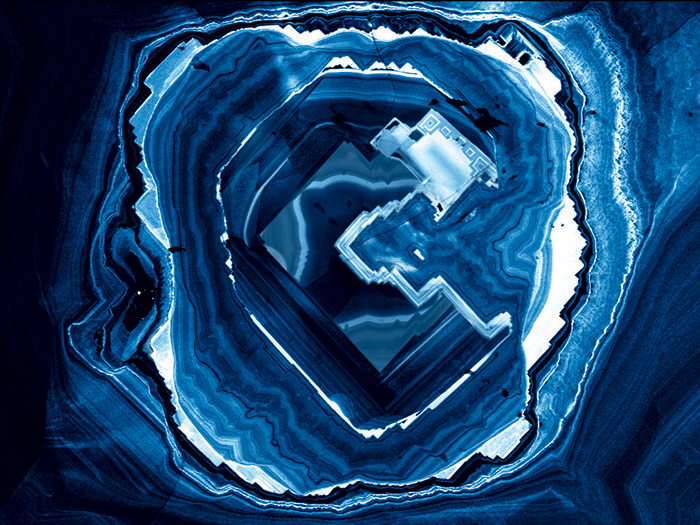
Aims and work plan for 2013
The aims of the project, as expanded in 2011 and 2012, will be followed and further expanded in 2013.
The new excimer-based LA-ICPMS system will be developed to carry out ultra-trace analyses of diamonds showing multiple stages of growth and/or mixed-habit growth, to quantify the trace-element characteristics of the fluids from which such diamonds grow. This can then be cross-compared with our extensive database of fluid compositions in fibrous diamonds. The new techniques also will be used to re-evaluate our older data on gem-quality diamonds, where many analyses were near the detection limits available at the time. C-isotope analyses will be done on the same diamonds, to correlate trace-element patterns with isotopic characteristics, and C-isotope studies on zoned and centre-cross diamonds will be completed.
Trace-element and isotopic analyses on UHP diamonds from Tibet, the Polar Urals and other localities (to be provided by Prof J-S. Yang, CAGS, Beijing), will be undertaken, forming an unanticipated a link to Foundation Project 1 and leading to a
new strand investigating the redox state of different mantle regions.
The PhD project of E. Rubanova will be completed, fulfilling the planned program of chemical, isotopic and microstructural analysis of the relevant diamonds, diamondites and diamondiferous xenoliths for thesis submission and publication.
False colour cathodoluminescence (CL) image of the core of a diamond cube from the Democratic Republic of Congo. While many natural diamond cubes are assumed to be of fibrous growth, detailed study has shown many contain cores of different diamond growth. Sometimes these cores are much older than the fibrous overgrowth. The cause of the blue CL are nitrogen defects within the diamond lattice. Image is approximately 1mm across.
This is one of the samples being worked on in collaboration with Dr Masahiko Honda (ANU RSES).
9. 4D lithospheric evolution and controls on mineral system distribution: The Western Superior-Yilgarn comparison
Theme 2, Earth Evolution, contributing to understanding Earth’s Architecture.
Aims of Project: The project will provide a very well-constrained case study in an Archaean craton outside of the Yilgarn to (1) apply multi-isotopic (U-Pb, Lu-Hf, O) analyses of zircon to map lithospheric architecture in space and time, (2) determine if the distribution of mineral systems (VMS, Fe, NiS, Au) shows strong control by this architecture, as it appears to in the Eastern Goldfields Superterrane of the Yilgarn Craton, and (3) generate mappable exploration criteria for targeting exploration for various Archaean mineral systems at the craton to terrane scale.
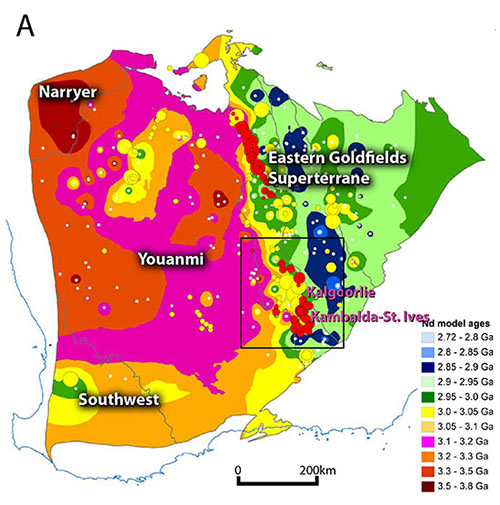
Figure 1. Nd model ages with Au (yellow) and Ni (red) deposits in Yilgarn Craton (After Cassidy and Champion, 2007).
Context and rationale: Recent studies (Champion and Cassidy, 2007; McCuaig et al., 2010; Mole et al., 2010; Begg et al., 2010) have demonstrated in the Yilgarn Craton of Western Australia that multi-isotopic maps (in-situ zircon U-Pb and Lu-Hf analyses combined with whole-rock Sm-Nd data) are a powerful tool to map crustal growth and image lithospheric blocks of different age (putative paleocraton margins). Moreover, these studies have pointed to a strong spatial correlation between these lithospheric block edges and the location of large concentrations of multiple styles of mineral deposits. The interpretation is that these isotopic boundaries mark lithosphere-scale structures that control the flux of mass and energy, and thus the location of large mineral systems through time.
The western Superior Province of Canada is the perfect place to undertake a comparative study to complement the Yilgarn example. The western Superior is host to major gold (Red Lake Camp, Musselwhite mine, Hemlo), VMS (Kidd Creek) and diamond (Victor Mine) deposits as well as the recent discoveries of the world-class chromite and nickel deposits in the Ring of Fire. Yet, the western Superior Province has important contrasts to the Yilgarn in that it is relatively VMS-rich, and NiS-poor. Moreover, the Western Superior is an exceptionally well constrained Archaean craton, with well defined stratigraphy, an abundance of high precision geochronology to constrain its evolution, and abundant high quality geophysical data including crustal seismic and potential field datasets. Current thinking is that the southwestern Superior Province comprises largely juvenile lithosphere at ca. 2.75-2.65 Ga, growing by combinations of arc-plume interactions and accretion of terranes. This contrasts the Yilgarn Craton, comprising largely evolved lithosphere at that time, and tectonic models that range from intracratonic rifting through to assembly of accretionary terranes. Systematic delineation of lithospheric blocks of different character would radically change the views on assembly of these ancient cratons.
Methodologies: This project will investigate the U-Pb, Lu-Hf and O isotope characteristics of zircons from key units in the Wabigoon subprovince of the western Superior Province, in order to obtain a better understanding of the evolution, architecture and preservation of this complex 3.0-2.7 Ga Archaean terrane and the mineral deposits that formed within it.
Progress during 2012
In 2012, we obtained 48 zircon separates from Don Davis and Kirsty Tomlinson. SHRIMP U-Pb dating and Cameca IMS O-isotope analysis have been conducted on 30 samples.
LA-MC-ICPMS Lu-Hf analysis has been done on 12 samples;
the remaining analysis is continuing.
Yongjun Lu collected another 114 samples during a field trip in August-September, 2012. Mineral separation and whole-rock geochemical analysis of these primary samples are ongoing.
We have secured a UWA scholarship for Katarina Bjorkman, who will join this project in February 2013 as a full-time PhD at CET
to study the Marmion Terrane in detail.
As part of this project, a collaboration with Pete Hollings at Lakehead University has been established under a NSERC Discovery Grant that will let us extend this work northward to Uchi/North Caribou boundary.
Branded under CCFS, the collaboration of zircon Hf mapping in Tibet with Zengqian Hou at CAGS has led to exciting discoveries, which will radically transform the division of the Lhasa Terrane. Manuscripts are in preparation.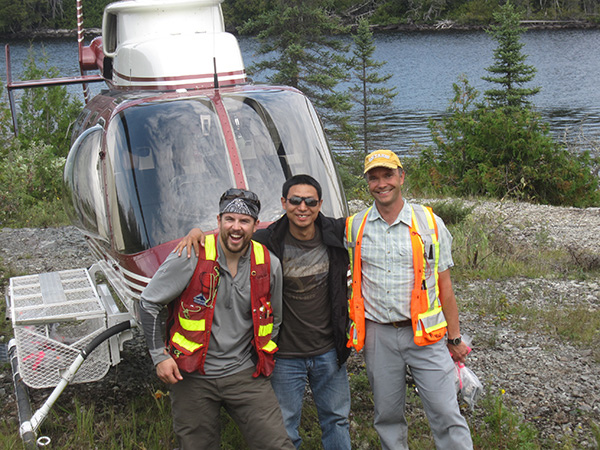
Outputs
Publications:
CCFS publications #23, 162, 167, 170, 185, 206, 222, 253, 255, 257, 258, 259, 260, 273
Aims and work plan for 2013
One of the major aims in 2013 is to obtain the SHRIMP U-Pb ages, oxygen- and hafnium-isotope compositions of zircons from ca 100 samples.
A field trip is scheduled in mid-2013 for additional sampling and the detailed study of Marmion Terrane as Katarina Bjorkman’s PhD project.
Data collection for E. Wabigoon will be finalised for writing a manuscript.
Figure 2. Sampling by helicopter around Thunder Bay, Canada. Yongjun Lu is accompanied by OGS colleagues Robert Cundari (left) and Mark Puumala (right).
10a. 3D architecture of the western Yilgarn Craton

Theme 2 and 3, Earth Evolution and Earth Today, contributing to understanding Earth’s Architecture.
This project is a major initiative by the Geological Survey of Western Australia (GSWA) to integrate the results of 1:100,000 scale regional mapping, geochronology and geochemistry with newly acquired high-quality geophysical data, including gravity and aeromagnetic data, and deep seismic and magnetotelluric surveys.
Aims:
The aims of the project are to integrate the data into a 4-dimensional, integrated model of crustal evolution for the western Yilgarn Craton, and to derive a better understanding of the mineralisation processes for this region, how the crust links to underlying lithospheric mantle, and what relationships this piece of lithosphere has with the more highly endowed, eastern part of the craton (Eastern Goldfields Superterrane (EGS)).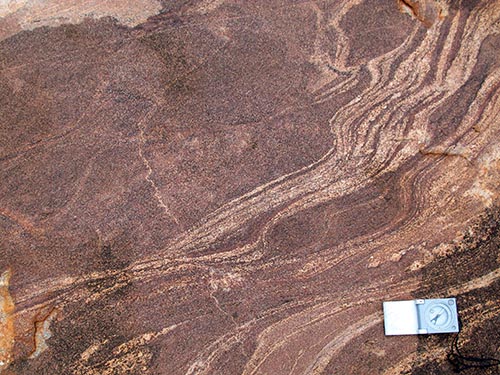
Context and rationale:
The Yilgarn Craton of Western Australia is a large and highly complex piece of Archean crust with a long history extending from 4.4–2.6 Ga. It is locally well endowed with a variety of mineral deposits, particularly gold and nickel in the EGS. Previous work has identified a number of lithostratigraphic terranes interpreted to have had distinct crustal histories prior to tectonic amalgamation at ca 2.65 Ga. However, recent work by the GSWA in the northwestern part ofthe craton has identified a long-lived, autochthonous history of crustal development there, including episodes of volcanism, granitic magmatism, shearing and gold mineralisation that are similar in composition and temporal development to those further east, in what has been interpreted as the accreted, younger part of the craton (EGS). This, together with a number of other features of the surface geology, suggests there are significant problems with current models of crustal development through arc-accretion tectonics.
High-temperature deformation in the Lakeside granite complex, Murchison domain, Yilgarn craton.
This project incorporates 2-D and 3-D imaging, modelling and analysis of newly acquired deep seismic, magnetotelluric, gravity, and aeromagnetic data along three linked transects totalling 700 km in length across the northwestern part of the Archean Yilgarn Craton, Australia. These geophysical data will be synthesised in conjunction with new geological data to develop an integrated lithospheric model of the Narryer and Youanmi terranes, and their relation to the Eastern Goldfields Superterrane. Additional studies will include integrated analysis of Lu-Hf in zircons from dated surface samples in order to better understand the roles of juvenile mantle additions to the crust and crustal recycling, and when these different, but possibly linked, factors occurred. The project involves close collaboration between staff of the Geological Survey of WA and researchers at Macquarie and UWA.
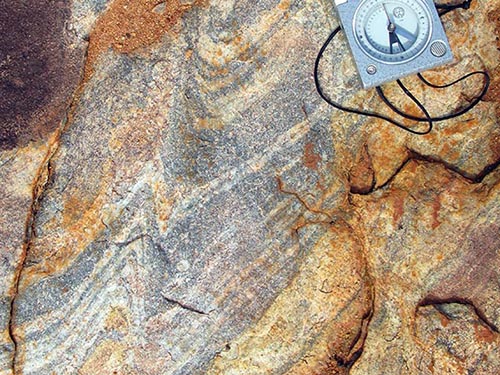
High-temperature deformation in the Yalgoo granite dome, Murchison domain, Yilgarn craton.
The proposed research project will apply well-established, existing research technologies to the previously poorly studied, and underexplored, northwestern part of the Yilgarn Craton: it is the first study of this kind to cover over more than half of the craton. The project is further innovative in developing an integrated research framework from mantle through to crust, involving a team of researchers with different expertise at a variety of scales.
Progress during 2012
Work on the Yilgarn craton in 2012 has focused on the interpretation of the Youanmi seismic reflection survey (http://www.dmp.wa.gov.au/11799.aspx) – a collaboration between the Geological Survey of Western Australia (GSWA) and Geoscience Australia. Activities included field work along the seismic traverses with the aim of relating geological observations to structures imaged in the reflection data.
The GSWA-funded Research Associate position within CCFS has been filled in 2012. Dr Huaiyu Yuan, currently at the University of California’s Berkeley Seismological Laboratory, will join CCFS in 2013. Employed through Macquarie University, Dr Yuan will be based at the Centre for Exploration Targeting at the University of Western Australia in Perth, where he will work on imaging the structure of the Australian lithospheric mantle.
Aims and work plan for 2013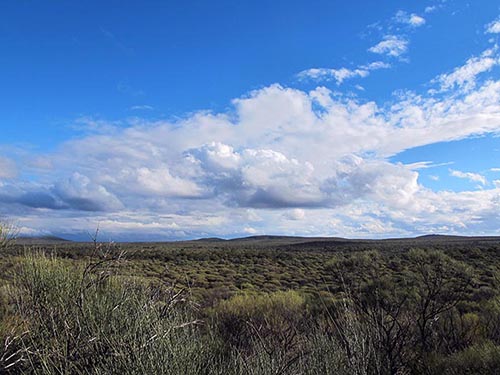
A one-day workshop led by the Geological Survey of Western Australia and Geoscience Australia on 27 February will present the results of the new seismic reflection and magnetotelluric data collected along the Youanmi and Southern Carnarvon seismic traverses across the northern Yilgarn Craton in Western Australia. A series of abstracts covering the preliminary interpretation of the seismic reflection data as well as magnetotelluric data, forward models and inversions of potential field data will become available on the GSWA website on the day of the workshop*. Using the preliminary results from the interpretation of the seismic reflection survey and other geophysical datasets and models, Dr Ruth Murdie and Dr Klaus Gessner will develop a 3D structural model of Earth’s crust in the northern Yilgarn.
* Youanmi and Southern Carnarvon seismic and magnetotelluric (MT) workshop 2013: extended abstracts, compiled by S Wyche, T.J. Ivanic and I. Zibra: Geological Survey of Western Australia, Record 2013/6.
Typical Yilgarn landscape near Golden Grove, Murchison domain, Yilgarn Craton.
10b. Zircon Lu–Hf constraints on Precambrian crustal evolution in Western Australia

Theme 2, Earth Evolution, contributing to understanding Earth’s Architecture.
Project Description
Modern geochronology has led to substantial advances in understanding the Precambrian geological evolution of Western Australia. However, in many cases it is unclear how rocks or terranes of similar age might be related. This project will obtain and integrate zircon Lu–Hf isotope data with other geological, geochemical and geophysical information to understand the evolution of the continental crust in specific areas of Western Australia.
Zircon Lu–Hf analyses provide insights into the relative contributions of juvenile sources and recycled crust to the continental crust through time, and ‘Event Signature’ curves permit the evolution of different crustal domains to be visually compared. Integrating these constraints with other isotopic and geochemical information, geological mapping, and recently acquired geophysical datasets will advance our understanding of geodynamics and test hypotheses of tectonic evolution. Efforts will be aimed at addressing specific geological questions in key areas, particularly along the new geophysical transects, as well as in under-explored regions (e.g. The Albany–Fraser and Capricorn Orogens) where the new information will improve the targeting of mineral exploration.
Measurement of hafnium isotopes in zircon crystals allows determination of the Hf isotope ratio at the time of zircon crystallisation. The ability to generate large amounts of data for zircons of a range of ages (within single crystals, single samples, and by compiling data from several samples) means that time-space variations in crustal evolution can be readily evaluated. The project will include analysis of detrital zircons in sedimentary rocks as well as zircons with multiple growth stages in both igneous and metamorphic rocks. In collaboration with GEMOC, isotopic analyses will be performed by laser-ablation ICPMS on zircons selected from the GSWA archive of >1000 samples dated using SHRIMP. This is the first time in Western Australia that Lu–Hf isotope data obtained on this scale can be integrated with geological and geochemical data and newly acquired gravity, aeromagnetic, seismic and magnetotelluric datasets.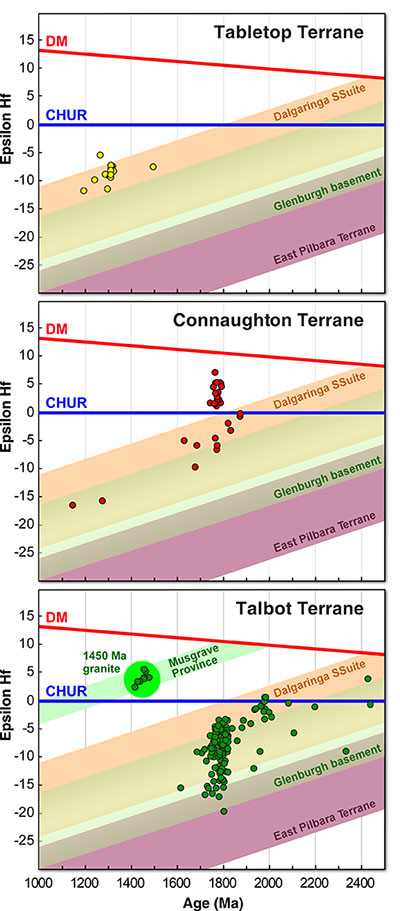
Progress during 2012
Zircons for Lu–Hf analysis were selected from the Pilbara and Yilgarn Cratons, the Rudall and Musgrave Provinces, the Albany–Fraser Orogen, and the Kimberley and Amadeus Basins. About 1300 analyses, from about 100 samples, were obtained in 2012. The results were integrated with existing isotope data, published in refereed journal articles and GSWA Records and Reports, and made available via GSWA’s web site.
New zircon Lu–Hf data from the Rudall Province indicate that its three constituent terranes (Connaughton, Tabletop, and Talbot) had similar source compositions, and that the isotopic compositions and ages of inherited zircons in Rudall Province rocks are similar to those of the Capricorn Orogen and other proximal regions of the West Australian Craton. This means that it is unnecessary to invoke a North Australian Craton (e.g. Arunta Orogen) origin for the terranes of the Rudall Province. Furthermore, 1.9 Ga Hf model ages and mantle-like oxygen isotopes in a 1450 Ma granite from the Rudall Province indicate crust formation at that time and suggest the existence of a ca
1.9 Ga underplate, similar to that recently inferred for the Musgrave Province.
New Lu–Hf results, together with existing isotope data, define model-age peaks in the central and eastern Yilgarn Craton at ca 4200, 3500, 3100, 2800, and 2700 Ma. The 3100, 2800, and 2700 Ma peaks likely correspond to crust formation events. The earliest peak is not recorded in the Eastern Goldfields Superterrane, indicating that crust formation in this region postdated the earliest development of the Yilgarn Craton.
The Eastern Goldfields Superterrane and Southern Cross Domain appear to have been subjected to major heating at ca 3100 and 2800 Ma, accompanying the generation of juvenile crust in the east and reworking of older crust in the west. However, the events at ca 3100 and 2800 Ma are recorded by both granite suites and greenstone successions across the craton, whereas the ca 2700 Ma event is most evident in the Eastern Goldfields Superterrane.
Outputs
Publications:
CCFS publications #61, 68, 78, 185, 209, 256, 264, 265, 266, 267, 274
Aims and work plan for 2013
The project will continue to generate Lu–Hf isotope data, and integrate them with geological and geochemical data as well as geophysical datasets. The research will be focused in ‘greenfields’ areas where little information presently exists. Based on results obtained, it is likely that new samples will be collected during the normal course of GSWA fieldwork to address specific geological problems.
Initial 176Hf/177Hf evolution diagram for Rudall Province samples compared to potential source regions. Most Arunta Orogen data are dissimilar to those for the Rudall Province, Capricorn Orogen, and East Pilbara Terrane.
Foundation Centre Technology Development projects
(Whole-of-Centre projects)
1. CAMECA Ion Microprobe development: Maximising the quality and efficiency of CCFS activities within the UWA Ion Probe Facility
Project Description
The Centre for Microscopy, Characterisation and Analysis at UWA is home to two state-of-the-art Secondary Ion Mass Spectrometers: the CAMECA IMS 1280 large-radius ion microprobe, for the high-precision analysis of stable isotopes in minerals, and the CAMECA NanoSIMS 50 for imaging mass spectrometry at the sub-micron scale. In addition to the analytical capabilities located at the other nodes, the CCFS is poised to become a world-leader in in-situ stable isotope analysis, and it is therefore essential that the data and interpretations be of the highest quality.
This project provides a dedicated Research Associate for the development of CCFS activities utilising the CAMECA Ion Microprobes at UWA, thereby increasing the capacity of the facility, enabling a higher degree of interaction and participation on projects, and allowing greater synergy with other CCFS node facilities. The Research Associate will play an integral role in experimental design, planning, sample preparation, and the acquisition, processing and interpretation of data. The complex nature of the Ion Microprobes demands a high-degree of technical ability, while an understanding of the aims of the individual projects requires a deep understanding of geological and geochemical processes. This position is fundamental to the generation of high-quality, in situ, elemental and isotopic data for a diverse range of projects and, as such, represents a significant investment into the overall success of the CCFS.
Progress and Achievements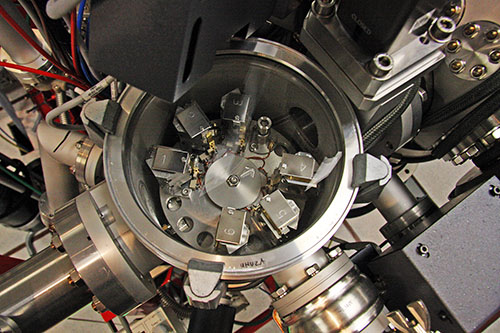
Dr Laure Martin was appointed to the position of Research Associate within the CMCA to facilitate the use of the ion probes by the CCFS. With a considerable background in geological SIMS analysis, Dr Martin has already made valuable contributions to the development of standards and analytical protocols, while providing assistance in sample preparation, data acquisition, and data processing. Next to this service role, Dr Martin also carries out her research on the evolution of fluids in subduction zones and mineral/fluid interaction in metamorphic rocks.
The Ion Probe Facility also employed Dr Rong Liu as a Senior Research Officer.
The ion probe facility has been highly active during the past year, with CCFS projects accounting for more than 30% of the available analysis time. See Technology Development.
Professor James Farquhar of the University of Maryland spent six weeks in the Ion Probe Facility as a UWA Gledden Visiting Senior Fellow Professor Farquhar carried out S isotope research using the Cameca IMS 1280 (pictured below)
Aims and work plan for 2013
Ion Probe Facility will continue in the development of standards, protocols, and the training of new staff where appropriate.
2. Frontiers in integrated laser-sampled trace-element and isotopic geoanalysis
The project aims to enhance the world-class facility for in-situ isotopic and elemental analysis at GEMOC, in order to maintain Australia’s LAM-ICPMS capabilities at international standards, and to advance beyond it in some aspects. The advances will be based on femtosecond-laser sampling and the coupling of instruments for simultaneous analysis.
Project Description
Research in CCFS depends critically on world-class geochemical and high-pressure experimental infrastructure. The on-going improvement and refinement of the geochemical methodologies and techniques is driven by the CCFS research program and the acquisition of new instrumentation. In 2010 GEMOC was awarded a $1.5M LIEF grant, to purchase a femto-second laser sampling system, a new quadrupole (Q-)ICP-MS and a single collector sector-field (SF-)ICP-MS. The stated aim of the LIEF proposal was to investigate ways of linking these instruments in different combinations with laser sampling, to achieve simultaneous analysis of two isotopic systems or trace-element data and isotopic data. Examples drawn from the LIEF bid illustrate the potential range of combinations, and their usefulness. Combinations of instruments can be achieved by splitting the ablation gas into two lines downstream from the ablation chamber, and using different instruments to analyse the two gas fractions.
This will allow a range of innovative analytical approaches, including:
1. U-Pb dating of zircon and other U-bearing minerals + Hf-isotope analysis
2. Os-isotopes of sulfide grains + trace elements (Q-ICP-MS) or S-isotopes (SF-ICP-MS)
3. Sr-isotopes (MC-ICP-MS) + Pb isotopes (SF-ICP-MS) in feldspars
4. “Non-conventional” stable isotopes (e.g. Li, Si, Mg, Ca, Fe, Ga, Cu, Zn, Mo, Se, Tl and other still unexplored systems; MC-ICP-MS) + trace elements (Q-ICP-MS)
With this enhanced capability, the plan is to expand the stable-isotope program, including:
- Mg, Fe, Si and Li isotopes in olivine from mantle-derived rocks as tracers of mantle processes: melting, metasomatism and the recycling of crustal material
- Mg, Ca and Si isotopes in chondrules, Ca-Al inclusions and other silicate phases in meteorites, as tracers of cosmogenic processes and their timescales
- Mg and Li isotopes in speleothems and microfossils to constrain past climate change
- Si isotopes in quartz from crustal rocks to study hydrothermal processes, and in SiC from kimberlites, to understand the fractionation of Si and C in mantle processes
- Cu, Fe, Zn, Mo, Se, S isotopes in ore systems, including sea-floor “black smoker” chimneys, to investigate biological and other low-T fractionation processes
In each case the collection of trace-element and isotopic data from the same analytical spot will provide better constraints on each data than if they were collected from different spots.
The development of new methodologies and applications in this project will provide more analytical options for CCFS researchers and create new research opportunities across all CCFS themes. This facility and the innovation that it represents will help maintain the high profile that Australian geoscience has enjoyed internationally, making it easier to attract high-quality researchers, postgraduate students and industry-related research funding.
Progress and Achievements
Planned innovations in the Geochemical Analysis Unit (GAU) at Macquarie University in the first term of the Centre of Excellence Core to Crust Fluid Systems, are based on new instruments that have been purchased with funding provided by an ARC LIEF grant. This equipment is needed to proceed with the development of the ‘split-system’ techniques in which two mass spectrometers (a MC-ICP-MS and an ICPMS) will be connected to a common laser source for novel simultaneous measurement of geochemical parameters. The current status of this new instrumentation is as follows:
Q-ICP-MS: An Agilent 7700cx Q-ICP-MS was installed in 2010, joining the existing stable of Q-ICPMS (3) and MC-ICPMS (2) instruments.
Femtosecond Laser Microprobe: An order was placed for a Photon Machines fs198 laser system in August 2011 and the instrument was installed in June 2012. The laser system has not been fully commissioned due to recurring damage to optics in the beam delivery system. A redesigned beam delivery system will be installed in January 2013.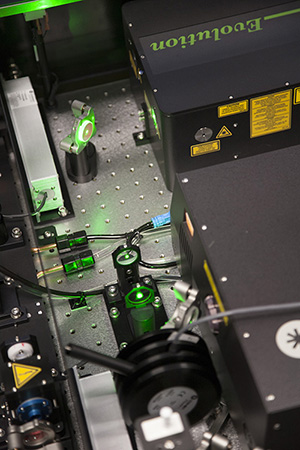
Instalation of the Photon Machines fs198 laser system in June 2012.
SF-ICP-MS: Following the order of the femtosecond laser, an order was placed for the Nu Attom high resolution SF-ICP-MS. The features of this instrument include continuously variable high-resolution capabilities, fast electrostatic scanning/jumping and a fully laminated, high-scan-speed magnet. Fast data acquisition is critical in the measurement of the transient signals produced by laser ablation and the performance and operation of the magnet in fast scanning mode during evaluation of the Nu Attom proved to be critical for the types of applications for which it is to be used. The Nu Attom was delivered in December 2012 and will be installed in January 2013.
In addition to the femto-second laser, a Photon Machines Excite 193nm excimer laser system was installed in June 2012. Since this time the Excite has been used with the Agilent 7700 for all in-situ U-Pb and trace-element analytical work.
The advancement of geochemical methodologies and techniques in the Geochemical Analysis Unit at Macquarie University continues to be a significant factor in the establishment of new research initiatives. While the issues with the femto-second laser system were being addressed by the manufacturer and with the delays in the delivery of the Nu Attom, a number of development projects were undertaken in support of CCFS-funded research programs. Specific developments in 2012 include:
- revision of GLITTER data reduction software and in-situ methodologies for trace-element analysis and U-Pb isotope measurements
- refinement of Li isotope methodologies for ultramafic rocks and adaptation to other applications (A-type granites, corals)
- on-going development of the procedures for the measurement of Mg isotope composition of garnet (development of potential microbeam standards for laser ablation MC-ICP-MS or SIMS)
- development of in-situ methods for the analysis of Re-Os isotopes in Pt-rich alloys and sulfides
- development of U-Pb geochronology of apatite
- refinement of in-situ Sr and Nd isotope ratio measurement of apatite
- determination of error budgets for isotope ratio measurements using Monte Carlo techniques
- development of whole-rock trace element analysis of fused glasses by laser ablation ICPMS
- development of new sample preparation methods for geochemical and isotope analysis in the GAU
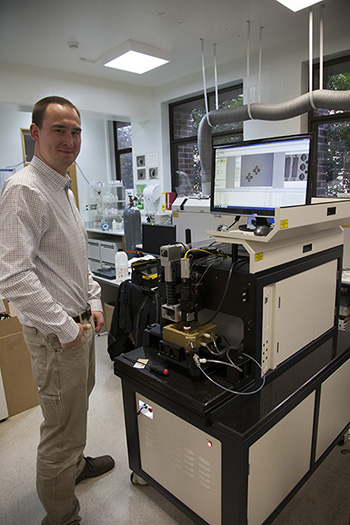
Aims and work plan for 2013
- Commissioning of femtosecond laser system (January 2013)
- Installation and commissioning of Nu Attom high resolution SF-ICP-MS (January 2013).
- The appointment of a Research Associate (Post-doctoral position) with existing expertise in laser sampling and ICP-MS analysis to undertake method development of the femtosecond laser system.
- Establish and undertake the first phase of an experimental program to investigate fundamental properties of femtosecond ablation processes in geological materials, focusing on laser-induced isotopic fractionation.
- Transfer of in-situ methodologies for trace-element analysis and U-Pb isotope measurements from the Q-ICP-MS to the Nu Attom.
- Development of split-stream laser ablation analysis using Q-ICP-MS (U-Pb isotopes) and MC-ICP-MS (Hf isotopes)
- Refinement of Li isotope methodologies and expansion to other applications.
- On-going development of the procedures for the measurement of Mg isotope composition of garnet.
Photon engineer Ben Staal intalling the new Photon Excite Excimer laser ablation system.
3. Optimising Mineral Processing Procedures: From Rock to Micro-Grains
Liberation and recovery of accessory mineral components of any type of rock, are critical stages in sample preparation for many types of geochemical and geochronological analysis. This project involves the development of new separation methods using state-of-the-art instruments to fragment rocks into their constituent components. Implementation of the new techniques will improve yields of high-purity mineral separates and provide the essential materials for analysis in the CCFS research and industry collaborative projects.
Project Description
Aims: Liberation and recovery of accessory mineral components of any type of rock, for geochemical and geochronological analysis.
The aims of many CCFS projects require the separation of accessory minerals from a range of different rock types. There are several major issues with these processes: breakage of grains, potential laboratory contamination, and the concentration and separation of extremely fine-grained phases. These problems can now be reduced if not eliminated by using new technology and newly developed procedures: (1) electrostatic pulse disaggregation (EPD); (2) the use of disposable sieves; (3) hydroseparation procedures for ultrafine material.
The first selFrag instrument in Australia was installed in GEMOC in May 2010. SelFrag uses EPD to break rock samples into their component phases and produces better liberation of mineral phases, especially accessory minerals, than conventional crushing procedures. Because disaggregation proceeds along grain boundaries, it greatly increases the proportion of unbroken grains. Disaggregation takes place inside a large Teflon-lined container, which is easily cleaned to prevent cross-contamination.
Examples:
- Zircon separation: Increasing the yield of zircon crystals for geochronology. The liberated zircon crystals are virtually unbroken and the surfaces are very clean. In contrast to mechanically crushed samples, no remnants of other minerals such as biotite have been found on the zircon surfaces.
- Separation of Platinum Group Minerals from chromite ores. Conventional mechanical crushing of compact chromite samples produces multi-mineral grains and excessive amounts of dust. The recovery of PGMs is very difficult. Selective fragmentation using selFrag, on the other hand, produces only small amounts of fines and no dust. Breakage occurs preferentially along grain boundaries and inclusions, thus liberating the platinum minerals.
- Separation of minor components from complex rocks, e.g. kimberlites and diamondites
Progress and Achievements
Since its installation selFrag has been used for a range of applications including zircon separation, the analysis of grain size and shape of phenocrysts in volcanic rocks, and the liberation of trace minerals from a range of mantle-derived and crustal rocks (e.g. alloys in mantle peridotites, platinum group minerals in chromitites). selFrag has increased the yield of zircon crystals and the liberated crystals are virtually unbroken and the surfaces are very clean. This has enabled the dating of rocks with low zircon abundances and expanded the application of the U-Pb technique to mantle geochronology.
In 2012 selFrag was used to process more than 190 samples for 45 different research projects, including CCFS research projects (TARDIS; PhD projects; Honours), TerraneChron and users from other institutions (e.g. ANU, Wollongong, NSW Geological Survey). Users are trained in the operation of selFrag and mineral separation procedures, and the training program is an important aspect of the facility’s operations and achievements. The defragmentation of each new rock type requires the development and refinement of experimental procedures depending on grain size, mineralogy and the amount of sample. A handbook of the most successful experimental conditions is being compiled. This is a valuable resource for users of all levels of experience and has contributed to the efficient functioning of the facility.
selFrag is the centrepiece of the facility for mineral separation at GEMOC, but for most samples it is the first stage in the separation process. In this project the following separation methods using material produced by selFrag have been developed and are being refined: 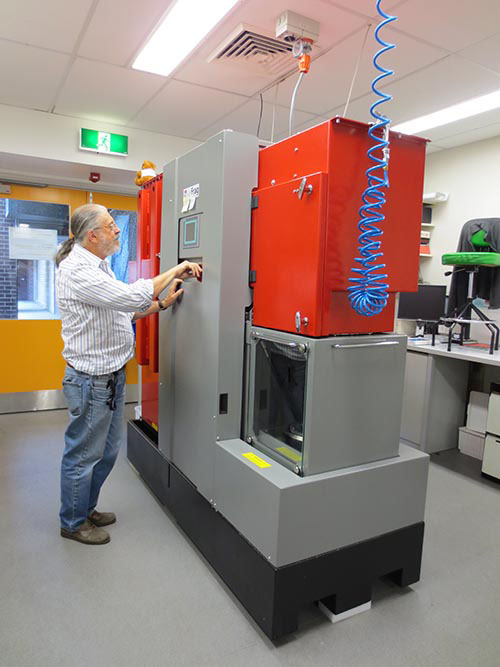
- sample sieving using disposable plastic/nylon sieves to prevent (cross-) contamination of samples
- heavy liquid mineral separation using aqueous solutions of the nontoxic chemical sodium polytungstate (SPT) for heavy-mineral separation.
- magnetic/paramagnetic separation using Frantz® Magnetic Barrier Laboratory Separator for separation of dry materials according to magnetic susceptibility, exploiting either paramagnetic or diamagnetic properties => output fractions: magnetic, paramagnetic and non-magnetic.
- micropanning equipment is available for further concentration of phases with densities slightly different from their matrix – best suited to grains >200 microns.
A hydroseparator (CNT-HS-11, manufactured by CNT Corporation, Canada) was purchased in 2011 and installed in 2012. This device processes samples of extremely fine-grained (down to a few microns) water-insoluble particles/grains to produce
“heavy-mineral concentrates” from material of similar physical properties. Methods are being developed to process the ultra-fine material from selFrag to concentrate rare accessory phases such as alloys in mantle peridotites and platinum group minerals in chromitites.
Steve Craven operating the selFrag.
Aims and work plan for 2013
The principal objectives for 2013 are to service the CCFS research programs requiring the production of high-purity mineral separates and to continue the transfer of the new mineral separation technologies by training researchers from other national and international universities.
Planned development and refinement of procedures and protocols for selFrag include:
- Expansion to new rock types as required
- Use of small volume cell to extract mineral inclusions
- Use of ‘sandwich-sieve’ to improve yield of ultra-fine materials from selFrag
- Adaptation of the hydro-separator to the separation of sub-10 µm zircon grains
The following projects are supported by ARC Post-Award funds allocated mid 2011 for early-career researchers. These are ARC ECSTAR Fellowships (Early Career Startup Awards for Research). The two appointees in 2011 were Dr José María González-Jiménez and Xuan-Ce Wang and a third, Takako Satsukawa, was appointed in 2012.
ECSTAR PRoject 1. Platinum-group minerals: monitors of deep Earth processes
José María González-Jiménez: Supported by ARC CCFS ECSTAR (commenced 2011)
Themes 2 and 3, Earth Evolution and Earth Today, contributing to understanding Earth’s Architecture and Fluid Fluxes. 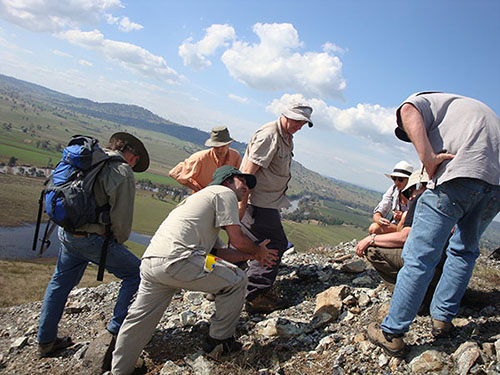
This project interfaces with Foundation Project 1, The TARDIS-E Project: “Tracking Ancient Residual Domains In the Silicate-Earth”. The Re-Os isotopic system in Platinum-Group Minerals (PGM) from Earth’s mantle potentially provides the most robust record of long-term interactions between distinct regions of Earth’s interior. However, the reliability of this approach needs further testing, because the chemistry of many PGM hosted in mantle-derived rocks has been modified by hydrothermal alteration or metamorphism during or before excavation of the mantle rocks from deep Earth to surface. The fact that PGM of different suites of mantle rocks exhibit variable scales of heterogeneity in Os isotopes suggests that post-magmatic alteration could also disturb the Re-Os compositions of these minerals. This project uses a combination of classical mineralogical methods and novel micro-analytical techniques for isotopic measurements to test the robustness of the Re-Os system in PGM from mantle-derived rocks affected by variable degrees of hydrothermal alteration and metamorphism, and thus to constrain the interpretation and applications of Os-isotope data.
José María González-Jiménez enlightening the eager crowd about the origins of SE Australian chromitites.
Progress during 2012
The sampling strategy for 2012 has been fully accomplished, and new samples of chromitites were collected in-situ by Dr González-Jiménez from ophiolites exposed in the Coolac Serpentinite Belt in southern Australia (low-temperature ocean-floor serpentinisation), the Vizcaino Peninsula in northern Mexico (mid-grade metamorphism) and the Dobromirtsi, Jakovitsa, Avren and Golyamo Kamenyane Ultramafic Massifs in southern Bulgaria (mid-to-high grade metamorphism). The preliminary petrographic study of the chromitites has revealed for the first time the presence of grains of laurite in the chromitites of the Coolac Serpentinite Belt. New PGM species that include members of the solid solutions of laurite (RuS2)-erlichmanite (OsS2) and irarsite(IrAS)-hollingworthite (RhAsS) were identified in the chromitites of the Vizcaino Peninsula. Previous studies had neglected to record the presence of these types of PGM. Abundant PGM grains were also identified and analysed for Re-Os isotopes in the chromitites of Dobromirtsi. These were treated and interpreted in a paper submitted to a special volume of Gondwana Research on “Ophiolitic Peridotites, Ultrahigh Pressure Minerals and Podiform Chromitites: Their Origin and Evolution”.
This project has also made progress in understanding the link between the mechanism of alteration of chromite and how the PGMs are altered. The analysis of the chromitites of the Golyamo Kamenyane Massif (Bulgaria) revealed that alteration of chromite takes place mainly during retrograde rather than prograde metamorphism, as previously proposed by many researchers (CCFS publication #176). The identification of different patterns of alteration of the chromite during metamorphism was used as a benchmark for the analysis of the mobility of trace and minor- elements in an aim to understand the types of fluids involved in the alteration process. This part of the work was carried out in collaboration with visting PhD students Vanessa Colas (University of Zaragoza, Spain) and Ria Mukjerhee (Jadavpur University, Kolkata, India). Their preliminary results have shown that the minor elements may be significantly mobilised during metamorphism, providing a new tool for identifying metamorphic alteration in chromitites that, at least in terms of major elements, appear not to be altered .
Finally, the application of the selFrag electrostatic rock disaggregation technique to whole-rock chromitite samples has allowed the identification of accessory zircons that allowed better constraints on the reliability of the Re-Os model ages of the PGMs. The preliminary results on the Dobromirtsi chromitites show that Re-Os model ages of primary PGM and Lu-Hf model ages obtained in the zircons match well, indicating the reliability of primary PGM for understanding magmatic events in the mantle.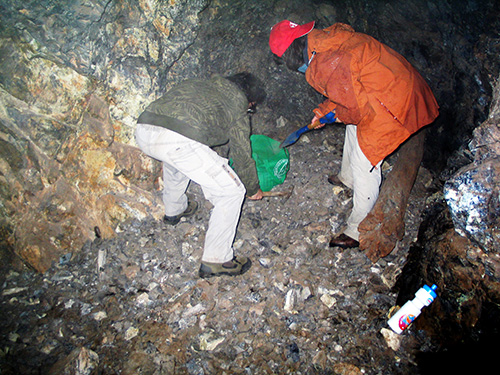
Aims and work plan for 2013
The strategic plan for 2013 aims to expand the set of PGM analysable for in-situ Re-Os isotopes by sampling PGM-bearing rocks from ultramafic bodies with well-established P-T conditions of post-magmatic alteration. This involves sampling of chromitites from ophiolites of southern Chile metamorphosed in amphibolite-facies. It also is planned to continue expanding the set of PGM potentially useful for Re-Os isotopes and zircons by obtaining concentrates from whole-rock samples using the combination of selFrag electrostatic rock disaggregation plus hydroseparation, both facilities being currently developed at the Geochemical Analysis Unit at CCFS/GEMOC. The new development of hydroseparation at CCFS/GEMOC is being carried out in collaboration with two Spanish labs from the University of Barcelona and Granada, which already have experience in the use of this technique. This is being carried out in close collaboration with CCFS/GEMOC and overseas collaborators. The project aims for 2013 also mesh with current research projects of undergraduate and postgraduate students under the supervision of the project leader. These include students from Earth Sciences departments of international Universities: National University of Mexico (UNAM, Mexico), Universities of Zaragoza and Barcelona (Spain) and the Geological Institute of the Bulgarian Academy of Science (BAS, Bulgaria). Communication of results is planned to be mainly through high-profile international scientific journals and presentations in high-profile international geoscience conferences.
José María González-Jiménez and Elena Belousova collecting chromitite samples in the Coolac Serpentinite Belt in southern Australia (beware of gabro monsters).
ECSTAR PRoject 2. Establishing the links between plate tectonics and mantle plume dynamics: message from the late Cenozoic Leiqiong basalts in SE Asia
Xuan-Ce Wang: Supported by ARC CCFS ECSTAR funding and NSFC (National Science Foundation of China) Project grant (commenced 2011)
Theme 2, Earth Evolution, contributing to understanding Earth’s Architecture and Fluid Fluxes.
Whether mantle plumes and plate subduction are genetically linked is a fundamental question that impinges on our understanding of how Earth works. Late Cenozoic basalts in Southeastern Asia are globally unique in relation to this question because they occur above a seismically-detected thermal plume adjacent to major deeply-subducted slabs that also have been imaged seismically. The main goal of this project is to examine the petrogenesis of late Cenozoic continental flood basalts (CFBs) that are located directly above the plume-like mantle seismic structure, and spatially close to major subduction zones in southeastern Asia. We will take a multidisciplinary approach, determining the chemical composition of the primary melts of the basalts, characterising the chemical compositions of their mantle source, and examining the temporal-spatial variations in the geochemical characteristics of the Leiqiong CFB. We will also test the geological and thermochronological evidence for lithosphere uplift. The results will be used to test major predictions of plume models as well as other end-member geodynamic models for such unique CFBs. This study will advance our understanding of (1) the thermochemical state of the deep Earth where a lower-mantle-rooted plume-like seismic structure exists unusually close to subducted slabs; (2) relationships between geophysical and geological manifestations of mantle plume activities at mantle downwellings; (3) the nature and origin of enriched mantle source regions; and (4) the behaviour of mantle plumes at plate boundaries and inter-relationships between mantle plume dynamics and plate tectonic processes. Knowledge obtained in this project will help to address one of the most fundamental questions in geodynamics: how the two major processes of whole-mantle convection, i.e. deep subduction that drives mantle downwelling, and mantle plumes that drive mantle upwelling, relate to and interact with each other.
Progress during 2012
During 2012, we acquired high-precision Pb, Sr, Nd, and Os isotope data for the Hainan flood basalts and compiled all published geochemical and isotopic data on the late Cenozoic basalts from the South China Sea and adjacent area. The most important finding for this year is that the source of the late Cenozoic basalts in this region contained both an ancient (4.5-4.4 Ga) mantle volume and a young (0.2-0.5 Ga) recycled component. Our work shows that less-contaminated and synchronous basaltic samples from the Hainan-Leizhou peninsula, the Indochina peninsula and South China Sea seamounts share the same isotopic and geochemical characteristics. They have FOZO-like Sr, Nd, and Pb isotopic compositions (the dominant lower mantle component) and plot within the field of typical plume-induced basalts (e.g. Hawaiian lavas). These basalts have primitive Pb-isotopic compositions that lie on, or very close to, 4.5- to 4.4-Ga-old geochrons on a 207Pb/204Pb versus 206Pb/204Pb diagram, suggesting a mantle source developed early in the Earth’s history (4.5–4.4 Ga). These new findings, along with existing geophysical, petrological, and geochemical evidence, confirm the existence of a lower mantle-rooted plume (the Hainan plume) fuelled by an ancient reservoir at the CMB. Furthermore, the geochemical modelling of the isotopic evolution of recycled components has several important implications. First, the recycled oceanic crust may be the dominant factor controlling Pb isotopic heterogeneities in OIB sources. Second, extremely high 187Re/188Os ratios recently reported in oceanic crust (80-675) would lead to very radiogenic Os isotopes (187Os/188Os = 2-12) over 1 Ga, suggesting that such a component cannot be present in pristine form in the LIS basalt source. Third, both ancient (ca 0.6 Ga) gabbro- and bulk oceanic crust-derived melts have distinctive Pb-Sr-Nd and Os isotopes that are significantly different from what we have observed in the natural LIS basalts. Overall, our modelling results show that the maximum age for the recycled components in the source of the LIS basalts is 0.5-0.2 Ga. This implies a mantle circulation at an average rate of about 1-3 cm/yr, which is similar to that of previous estimates for the Hawaiian mantle plume. The coexistence of an ancient mantle reservoir and young recycled materials in the young Hainan plume is consistent with the geophysical observation that this young plume is adjacent to deep subducted slab-like seismic structures just above the Core-Mantle Boundary. We speculate that the continued deep subduction and the presence of a dense segregated basaltic layer may have triggered the plumes to rise from the thermal-chemical pile. This study may therefore provide the first observational support for dynamic linkages between deep subduction and mantle plume generation.
Xuan-Ce Wang in the field.
Aims and work plan for 2013
In 2013, the core task is to conduct the chemical and isotopic analyses and to synthesise the all acquired geochemical, isotopic, and petrological data to examine the interplay between plume and lithosphere. The specific aims in 2013 are the following:
(1) To conduct chemical and isotopic analysis and 39Ar/40Ar dating on the drill-core samples of the Hainan basalts in order to examine temporal-spatial chemical variations.
(2) To conduct Re-Os isotopic and PGE chemical analysis on the mantle xenoliths hosted by the Hainan alkalic basalts that will help us to determine the age of the subcontinental lithospheric mantle beneath Hainan Island. This will enable us to quantify the contribution of sub-continental lithospheric mantle to the Hainan basalts.
(3) Through combining outcomes as stated in Aims 1 and 2 and existing data, we will examine the interplay between mantle plume and lithosphere.
(4) To synthesise all the geochemical, isotopic, petrological, geophysical, and geological data to unravel the possible effects of the Hainan plume on the opening and evolution of the South China Sea.
(5) To evaluate the effect of alteration on the whole-rock chemical isotopic compositions and to examine the relationship between chemical variation and depth in drill core samples. The results from the Hawaiian OIBs will help us to decipher the commonalities and differences between the Hainan and Hawaiian plumes.
Outputs
Publications:
2012 CCFS publications # 16, 24, 156, 159, 193, 195, 270
Conference abstracts:
X.-C. Wang, Z.-X. Li, Q.-L. Li and X.-H. Li, A mantle hydrated by stagnated Pacific slab that produced intraplate continental flood basalts in northeastern China. Abstract, 34th International Geological Congress, Brisbane, 5-10 August 2012.
ECSTAR PROJECT 3. Mapping the deformation of subcontinental lithosphere: The evolution of microstructure and fluid-melt-rock interaction in the uppermost mantle
Takako Satsukawa: Supported by ARC CCFS ECSTAR funding (commenced 2012)
Themes 2 and 3, Earth Evolution and Earth Today, contributing to understanding Earth’s Architecture and Fluid Fluxes.
This project interfaces with Foundation Project 1, The TARDIS-E Project: “Tracking Ancient Residual Domains In the Silicate-Earth”.
The deep Earth water cycle is strongly coupled to plate tectonics, and the evolution of the uppermost mantle is commonly controlled by partial melting and/or refertilisation processes. The amount of water carried into the deep mantle by descending oceanic crust is relatively small, but even trace amounts of water affect physical and chemical properties such as melting temperature, rheology, deformation mechanism, electrical conductivity, etc.
Cratons are domains of thick lithosphere with cold geotherms, which have remained stable for long geologic periods since their formation. The processes that result in the stability or destruction of the cratonic mantle roots are poorly understood, and are a major open question in geodynamics. In this project, we mainly focus on the rheology of the uppermost mantle and the history of the roots of ancient continents to provide new constraints on the rheological properties of the lithospheric mantle. The development of a systematic approach combining microstructural analysis, the mapping of Crystallographic Preferred Orientations (CPO), water contents, numerical modelling of the seismic properties of individual samples, and geochemical analyses of xenoliths from different lithospheric levels and different degrees of melt-rock interaction. Previous work by GEMOC has focused on geochemical analysis; we will develop a new methodology for mapping ‘hidden’ microstructures by combining these approaches. This approach will provide new tools for the investigation of rock deformation, the rheological state of the mantle and the styles of mantle dynamics. As this project has just started, we are now characterising the microstructural evolution of mantle-derived rocks from the cratonic lithosphere by exploring the CPO mapping of a statistically representative sample set, which previously was well characterised geochemically.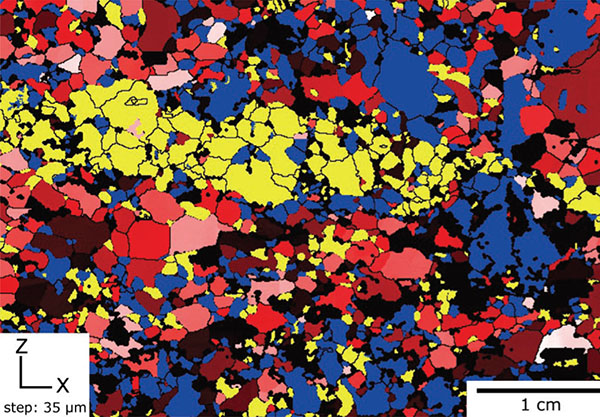
EBSD map of a peridotite xenolith from Ichinomegata (NE Japan).
Aims and work plan for 2013
1.To estimate water contents of peridotite xenoliths from Kaapvaal craton for the better understanding of water distribution beneath the craton, as existing water-content studies in this region have used limited numbers of samples.
2.To develop a robust model for the deformation history of the roots of ancient continents (subcontinental lithospheric mantle) by using the constraints derived from microstructural characteristics. These sample sets are from the North China Craton (NCC) and the Kaapvaal craton, and are well- characterised geochemically and petrologically.
3.To calculate CPO-derived seismic properties which will provide a unique basis for comparison with the detailed seismological data available in these areas.

 ARC Centre of Excellence for Core to Crust Fluid Systems
ARC Centre of Excellence for Core to Crust Fluid Systems